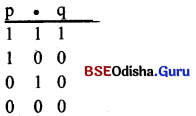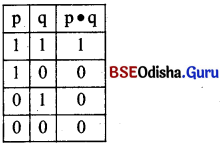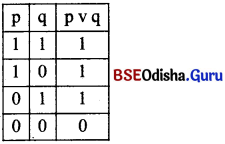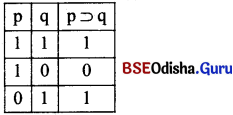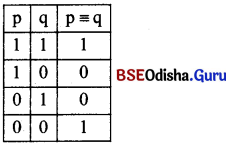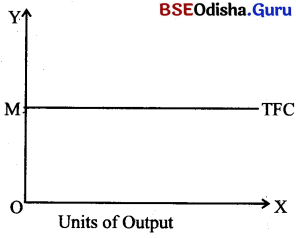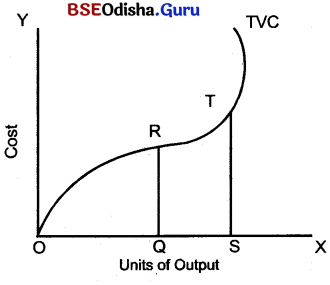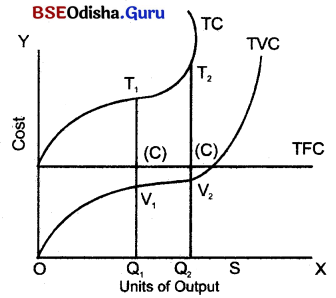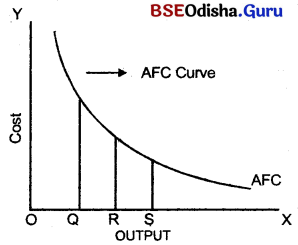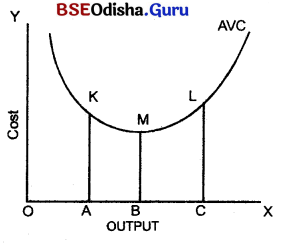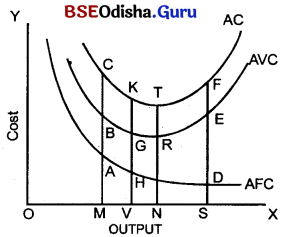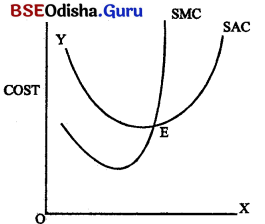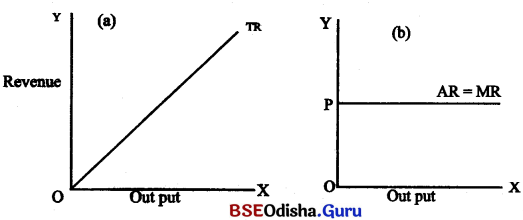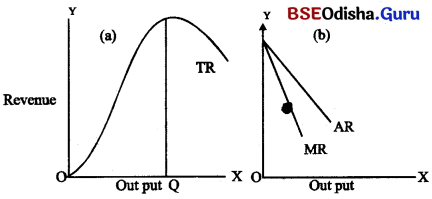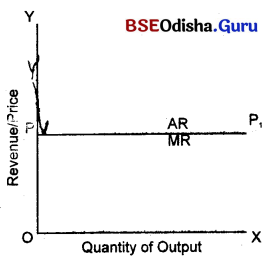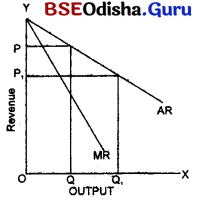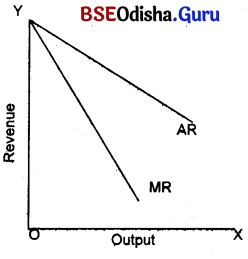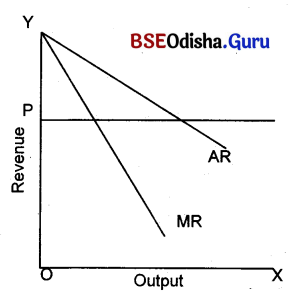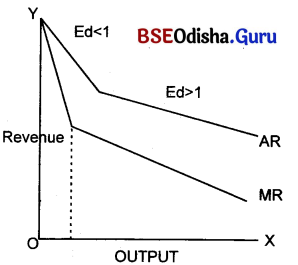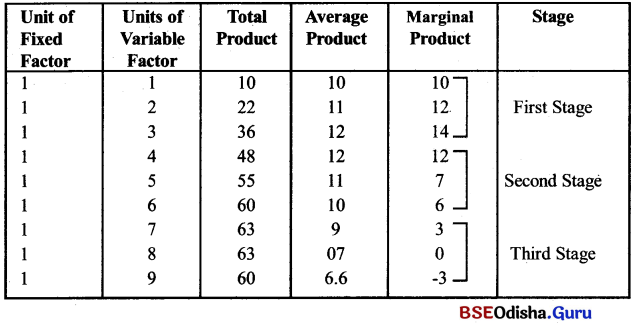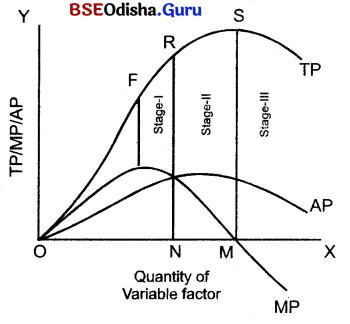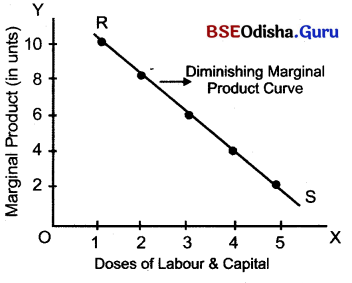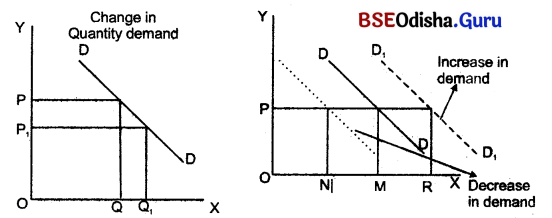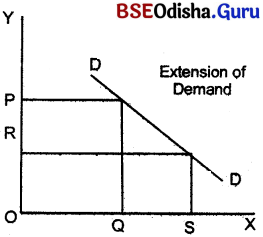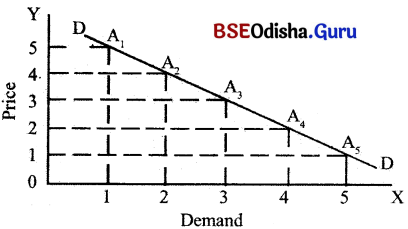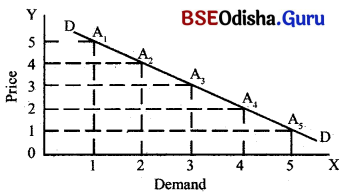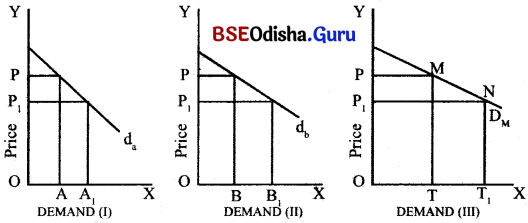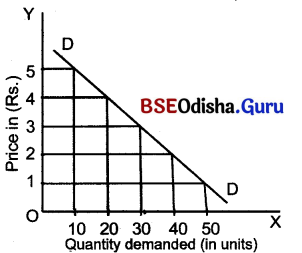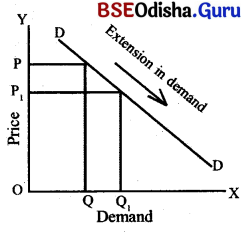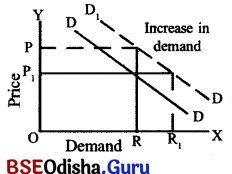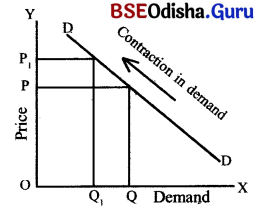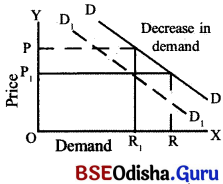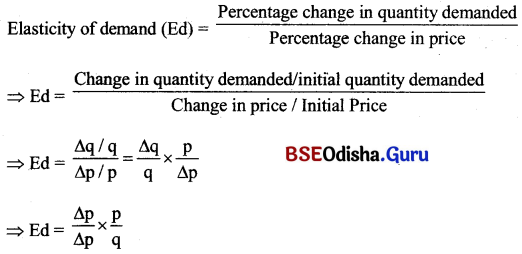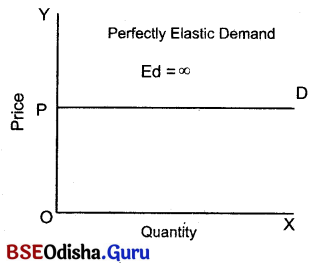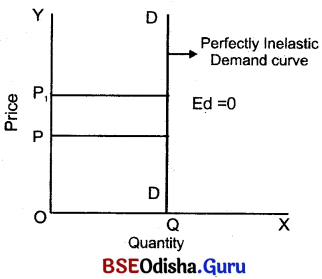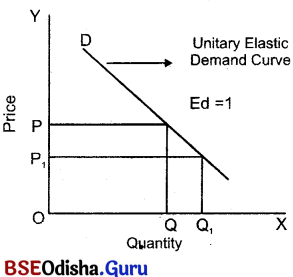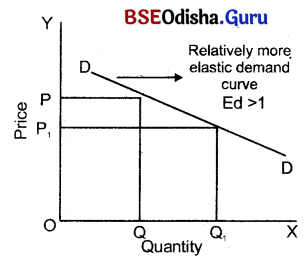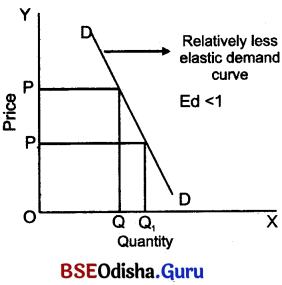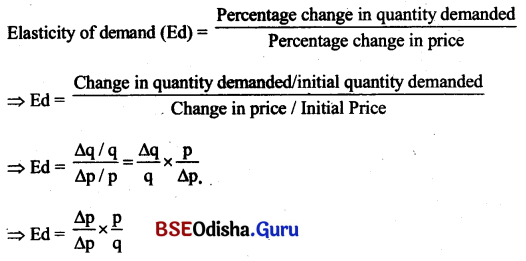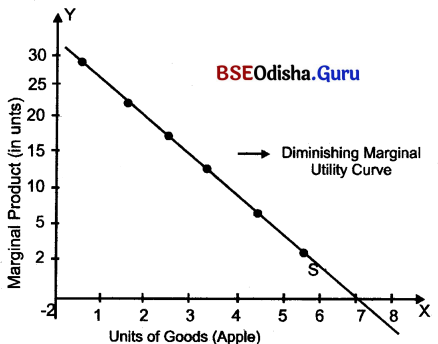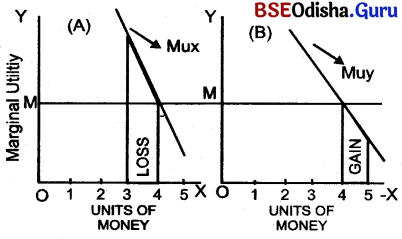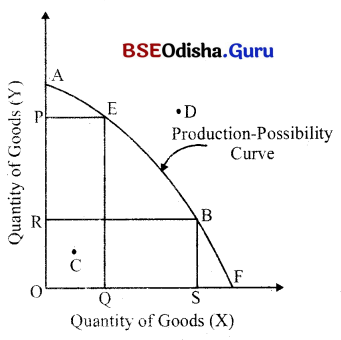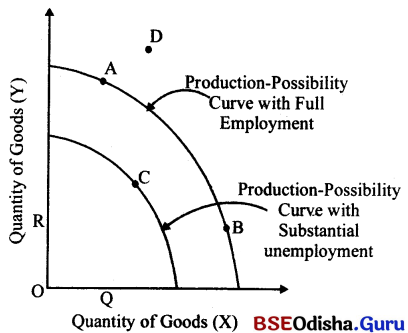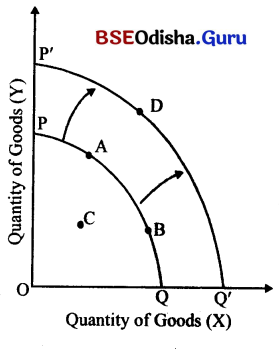Odisha State Board CHSE Odisha Class 12 Logic Solutions Chapter 2 Syllogism Questions and Answers.
CHSE Odisha 12th Class Logic Chapter 2 Question Answer Syllogism
Group – A
Short type Questions with Answers
I. Answer with in Two/Three sentence!
Question 1.
Write the 3rd figure of syllogism.
Answer:
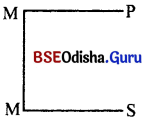
(i) In this figure middle term (m) is present subject place in both the premises.
(ii) The major term (p) is present in the predicate place of the major premise and the minor term is (s) present in the predicate place of the minor premise.
Question 2.
What is the position of the middle term in the fourth figure?

Answer:
(i) Middle term (m) is present in the predicate place of the major premise.
(ii) Middle term is present subject place of the minor premise.
Question 3.
Write any three general rules of syllogism.
Answer:
(i) Rule ‘3 ’ states that middle term must be distributed at least once in any of the premises.
(ii) From two negative premises no conclusion follows (Rule-5)
(iii) From two particular premises no conclusion follows (Rule-8)
Question 4.
Write the valid moods of the 3rd figure.
Answer:
(i) There are six valid moods in the third figure.
(ii) These are : DARAPTI, DATISI, DISAMIS, FELAPTION, FERISON, BOCARDO.
Question 5.
Name the valid moods of 4th figure.
Answer:
(i) There are 5 valid moods in the 4th figure.
(ii) These are BRAMANTIP, CAMENES, FESAPO, FRESISON, DIMARIS.
Question 6.
Give the symbolic example of BAROCO.
Answer:
(i) ‘BAROCO’ is the valid mood of 2nd figure.
(ii) Symbolic example;
A = All P is M
O = Some S is not M
∴ O = Some S is not P
Question 7.
Write the names of the perfect moods.
Answer:
(i) There are 4 perfect moods in syllogism.
(ii) These are BARBARA, DARII, CELARENT, FERIO
Question 8.
Write the names of the imperfect moods.
Answer:
(i) There are 15 imperfect moods in syllogis
(ii) These are, CAMESTRES, CESARE, FESTINO, BAROCO, DARAPTI, DATISI, DISAMIS, FELAPTON, FERISON, BOCARDO, BRAMANTIP, CAMENES, FESAPO, FRESISON, DIMARIS.
Question 9.
Write the special syllogistic rules of the first figure.
Answer:
(i) There are two special syllogistic rules in the 1st figure. These are
(ii) Major premise must be universal.
(iii) Minor premise most be affirmative.

Question 10.
State the special syllogistic rules of the 2nd figure.
Answer:
- There are three special syllogistics rules in the 2nd figure. These are-
- Major premise must be universal.
- Conclusion must be negative –
- Out of two premises, one premise must be negative.
Question 11.
State the special syllogistic rules of the 3rd figure.
Answer:
- The minor premise must be affirmative.
- The conclusion must be particular.
- One of the premises must be universal.
Question 12.
Write the special syllogistic rules of the 4th figure.
Answer:
- If the major premise is affirmative, the minor premise must be universal.
- If the minor premises is affirmative the conclusion must be particular.
- If either premise is negative, the major premise must be universal.
II. Answer within Five/Six sentence :
Question 1.
Why is syllogism called a mediate deductive inference?
Answer:
An inference is said to be mediate if the conclusion is drawn from. More than one premises and it is said to be deductive if the conclusion is never more general that the premises. In a syllogism the conclusion follows form two premises taken jointly and the conclusion cannot be more general than the premises. So a syllogism is called a mediate deductive inference.
Question 2.
How the figure of the syllogism is determined?
Answer: Figure of the syllogism is mainly determined by the position of the middle term. It may be the subject in both the premises, or predicate in both the premises or subject in minor and predicate in major subject in major and predicate in minor. There are four figures which are-

Question 3.
What is the fallacy of illicit minor?
Answer:
In a syllogism, if the minor term (s) is distributed in the conclusion but not distributed minor premise at that time we commit the fallacy of illicit minor.
Example :

In this example the minor term(s) is distributed in the conclusion but it is not distributed in the minor premise, so it leads to the fallacy of illicit minor.
Question 4.
Explain the fallacy of illicit major.
Answer:
In a syllogism, if the major term (p) is distributed in the conclusion but not distributed in the major premise that is called the fallacy of illicit major.
Example :

Here the major term (mortal) is distributed in the conclusion but not distributed in the major premise. So it leads to the fallacy of illicit major.
Question 5.
What is mood of syllogism?
Answer:
Mood of a syllogism is mainly determined by the quality and quantity of the premises. According to quality or quantity the propositions are A. E. I. O. on the basis of quality and quantity (A, E, I, O) the possible combinations are AA, AE, AI, AO, EA, EO, OA, IA, IE, II, 10, OE, 01, OO. According to first group of logicians there are only 16 x 4 = 46 possible moods. According to second group of logicians there are only 64 x 4 = 256 possible moods. According to Aristotle, there are 19 valid moods.
Question 6.
What is the fallacy of illicit Minor?
Answer: When the minor term is distributed in the conclusion without being distributed in the minor premise, we commit the fallacy of illicit minor.
Example :
E = No M is P.
A = All M is S.
E = No S is P
Here the minor term (p) is distributed in the conclusion but not distributed in the minor premise. So we commit the fallacy of illicit minor.
Question 7.
Explain the fallacy of undistributed middle.
Answer:
According to the third general syllogistic rule, middle term must be distributed at least once in any of the premise of a syllogism. But if the middle term is not distributed in any of the premises then we commit the fallacy of undistributed middle.
Example :

The above example is a fallacy of undistributed middle, because here the middle term (M) is not distributed in any of the premises.
Question 8.
Give a concrete example of valid argument in figure III.
Answer:
E = No men are birds.
A = All men are biped.
∴ O = Some biped beings are not birds.
This is the concrete example of the valid mood of third figure which is called FELAPTON.
Question 9.
Give an example of ‘A’ proposition and find out its converse.
Answer:
A = All men are mortal.
Converse I = some mortal beings are men.
A = All Sis P.
Converse I = Some P is S.

Question 10.
Give concrete example of the mood ‘CESARE’.
Answer:
E = No men are birds.
A = All crows are birds.
E = No crows are men
Question 11.
Give a symbolic example of the mood ‘BRAMANTlP’.
Answer:
A = All P is M
A = All M is S
∴ I = Some S is P.
Question 12.
Give an example of a valid syllogistic argument in which the middle term is distributed in both the premises.
Answer:
E = No M is P
A = All M is S
∴ O = Some S is not P.
This FELAPTON, a valid mood 3rd figure, where the middle term is distributed in both the premises.
Question 13.
Give an example of a valid syllogistic argument in which the major term is distributed in the premise but not in the conclusion.
Answer: A = All P is M
A = A11 M is S.
∴ I = Som S is P
This is BRAMANTlP, a valid mood in 4th figure, I where the major term is distributed in the premises but not distributed in the conclusion.
Question 14.
Write the special syllogistic rules of the figure one.
Answer:
(i) Major premise must be universal
(ii) Minor premise must be affirmative.
Question 15.
Name the moods of the 1st figure to which the following moods can be directly reduced BAROCO, BOCARDO, BRAMANTlP.
Answer:
BAROCO = FERIO. BOCARDO = DARIT. BRAMANTlP = BARBARA.
Question 16.
State the structure of a syllogism.
Answer:
A syllogism is consisted of three propositions, out of which the first two are called premises and the last one is called conclusion. The first proposition of syllogism is called major premise and the second proposition is called Minor premise. It is also consisted of three terms, such as; Major term (P) minor term (S) and middle term (m). The predicate part of the conclusion of a syllogism is called major term (P), the subject part of the conclusion of syllogism is called Minor term (s) and the common term between the premises is cabled middle term (M).
Question 17.
What is syllogism?
Answer:
Syllogism is a kind of mediate form of deductive inference where the conclusion is drawn out of two premises taken jointly but not separately. It is consisted of three terms like-major (p), minor (S) and middle term. It is consted of 3 propositions.
Example :

Question 18.
What is the fallacy of two particular premises.
Answer:
The general syllogistic rule says that if both their premises are particular then no conclusion follows. But if we draw any conclusion, out of two particular premises then we commit the fallacy of two particular premises.
Example:
I = Some mangoes are sweet.
O = Some fruits are not mangoes.
∴ O = Some fruits are not sweet.
Question 19.
Explain the fallacy of “Train of syllogism”?
Answer:
According to the general syllogistic rule, A syllogism must be consisted of three propositions, neither more or nor less. But if a syllogism is consisted of more than three propositions than we commit a fallacy, which is called the fallacy of train of syllogism.
Example :
All animals are mortal.
All men are mortal. Ram is a man
∴ Ram is mortal.
This argument is fallacious because it is consisted of 4 propositions.
Question 20.
What is the fallacy of ‘Four Terms’ ?
Answer:
A syllogism must be consisted of three terms, neither more not less. But if syllogism is consisted of more than three terms, than the fallacy arises, which as called the fallacy of ‘FOUR TERMS’.
Example :
God is the creator of man Man is the creator of sin,
God is the creator of sin.
Question 21.
What is meant by fundamental mood?
Answer:
A fundamental mood is a valid syllogism where the premises are just sufficient fttr the conclusion. Here the middle term is distributed only once and whatever other term is distributed in the premises are also distributed in the conclusion. The following 15 moods are fundamental.
Figure-I = BARBARA, DARII, CELARENT, FERIO.
Figure-II = CAMESTRES, CASARE, FESTINO, BAROCO .
Figure-III = DATISI, DISAM1S, FERISON, BOCARDO
Figure-IV = CAMENES, DIMARIS, FERESION,
Question 22.
Name the valid moods of flgure-III.
Answer:
DARAPTI, DATISI, DISAMIS, FELAPTON, FERISON, BOCARDO.
Question 23.
Name the valid moods of the first figure.
Answer:
- BARBARA,
- DARII,
- CELARENT,
- FERIO
Question 24.
Write short notes on the strengthed moods.
Answer:
A mood is said to be strengthened, if one of its premises is unnecessarily stronger than what is required to prove the conclusion. In the case of a strengthened mood even if a universal premise be substituted by its corresponding particular proposition, still the same conclusion follows. The following eight moods are strengthened.
Fig I = Barbari, Celaront.
Fig II = Cesaro, Camestrop
Fig III – Darapti, Felapton
Fig IV = Bramantip, Fesapo.
Question 25.
What is called weakened mood?
Answer:
A mood is said to be weakened, if its conclusion is weaker than what i$ justified by its premises. Though the premises can validate a universal conclusion, in a weakened a universal conclusion, the corresponding particular proposition, is drawn as the conclusion. The following five moods are weakened.
Fig I = Barbari, cetaront
Fig II = Cesaro, camestrop
Fig III = Camerop
Question 26.
Write any two general syllogistic rules are :
Answer:
(i) If one of the premise be negative, the conclusion is negative.
(ii) If one of the premise be particular the conclusion must be particular.
Question 27.
Distinguish-between immediate and mediate inference.
Answer:
Immediate inference is a kind of deductive inference in which the conclusion is drawn out of the only one premise.
Example :
All men are mortal.
Some mortal beings are men.
It is divided into 4 types, such as conversion, obversion, inversion and contraposition. Mediate inference is a kind of deductive inference in which the conclusion is drawn out of two premises taken jointly but not separately. It is otherwise called as syllogism.
Example :
A = All men are mortal.
A = All. students are men.
A = All students are mental.
Question 28.
What are the different kinds of inference?
Answer:
Inference is of two kinds, called deductive inference and inductive inference. Deductive inference is again of two kinds called immediate and mediate inference. Mediate inference which is also called syllogism can be pure or mixed.
Question 29.
Name the valid moods of 2nd figure.
Answer:
There are only four valid moods in the second figure. These are; CAMESTRES, CESARE. FESTINO, BAROCO.

Question 30.
Name the valid moods of 4th figure.
Answer:
There are only five valid moods in the fourth figure. These are; BRAMANTIP = AAI, CAMENES = AEE; FESAPO = EAO, FRESISON = E10, DIMARIS = LAI.
Question 31.
Give a symbolic example of BARBARA.
Answer:
Symbolic example of BARBARA.

Question 32.
Give the symbolic expression of DARII.
Answer:
Symbolic expression of DARII.

Question 33.
Give the Symbolic expression of CELARENT.
Answer:
Symbolic expression of CELARENT.

Question 34.
Write the symbolic example of FERIO.
Answer:
Symbolic example of FERIO.

Question 35.
Write the symbolic expression of GAMESTERS.
Answer:
Symbolic expression of GAMESTERS.

Question 36.
Write the symbolic expression of CESARE.
Answer:
Symbolic expression of CESARE.

Question 37.
Write the symbolic expression of FESTINO.
Answer:
Symbolic expression of FESTINO.

Question 38.
State the symbolic expression of BAROCO.
Answer:
BAROCO is the valid mood of 2nd figure. The symbolic expression of BAROCO

Question 39.
State the symbolic expression of DARAPTI.
Answer:
‘DARAPTI’ is the valid mood of third figure.
The symbolic expression of DARAPTI is →

Question 40.
State the symbolic expression of DISAMIS.
Answer:
‘DISAMIS’ is the valid mood of 3rd figure. The symbolic expression of ‘DISAMIS’ is →

Question 41.
Give the symbolic expression of FELAPTON.
Answer:
‘FELAPTON’ is the valid mood of third figure. The symbolic expression of FELAPTON is →

Question 42.
State the symbolic example of ‘BOCARDO’.
Answer:
‘BOCARDO’ is the valid Mood of third figure. It is symbolic expression is:

Question 43.
State the symbolic example of CAMENES.
Answer:
‘CAMENES’ is the valid mood of 4th figure. It is symbolic expression is;

Question 44.
State the symbolic expression of “FESAPO”.
Answer:
‘FESAPO’ is the valid mood of 4th figure.
The symbolic expression of ‘FESAPO’ is →

Question 45.
Write the symbolic expression of FRESISON.
Answer:
FRESISON is the valid mood of 4th figure. It is symbolic expression is;

Question 46.
Write the symbolic expression of DIMARIS.
Answer:
DIMARIS is the valid mood of 4th figure.
Its symbolic expression is;

Question 47.
Write the special syllogistic rules of the figure 3.
Answer:
The following are the special rules of the third figure.
- The minor premise must be affirmative.
- One of the premises must be universal.
- The conclusion must be particular.
Question 48.
What is called the fallacy of ‘Four Terms’?
Answer:
According to the general syllogistic rule, syllogism must be consisted of only three terms, neither more or less. But if a syllogism is consisted of more than 3 terms we the commit the fallacy of Four Terms.
Example :

This argument is fallacious because it is consisted of 4 terms.
Question 49.
Why the 1st figure is called perfect figure?
Answer:
According to Aristotle, first figure is called the perfect figure, because it follows a principle what calls is “Dictem deomini etnullo”, which literally means “statement concerning all and none”. According to him the moods of 2nd, 3rd and 4th figure will be tested by transforming to the moods of the 1st figure.
Question 50.
State Aristotles Dictum.
Answer:
For testing the validity of moods Aristotle had framed one rule, which is called “Aristotle’s dictum de omniet nullo”. Which means statements concerning all one none we state the rule thus.
- It something is true of all of a class, it can be affirmed of some of that class.
- If something is true of none of a class, it can be denied of some of that class.
- Example :
All M is P.
All S is M.
All S is P.
Question 51.
State the necessary of reduction in a syllogism.
Answer:
Reduction, in wide sense means transformation of moods of any figure to any other figure but in narrow sense it means changing the moods of 2nd, 3rd & 4th figure to 1st figure. Hence according to Aristotle 1st figure is the perfect figure because the dictem is applicable to the first figure. Hence reduction may be defined as the transformation of the moods to the imperfect figures to die moods of the 1 st figure there by proving the correctness of the moods of the so called imperfectTigures. That is why reduction is necessary.
Question 52.
State the special rules of 4th figures.
Answer:
The special rules of 4th figures are.
- If the major premise is affirmative, the minor premise must be universal.
- If any premise is negative, the major premise must be universal. .
- Both the premises cannot be negative.
- If the minor premise is affirmative, the conclusion is particular.
Question 53.
State the special syllogistic rules of figure-11.
Answer:
The special rules of figure II are :
- The major premise must be universal.
- One of the premises must be negative.
- The conclusion must be negative.
Question 54.
Name the special syllogistic rules of Figure one.
Answer:
There are two special syllogistic rules in the figure on these are,
(i) Major premise musrte universal.
(ii) Minor premise must be affirmative.
Question 55.
What is Reduction?
Answer:
Reduction is the process of proving the validity of the moods of the imperfect figures with the help of the moods of the perfect first figure. Direct reduction is the process of directly transforming a mOod of imperfect figure to a mood of perfect figure. Indirect reduction is the process of showing that some moods of 2nd, 3rd and 4th figures are such that the conclusion cannot be false if the premises are true.
Question 56.
What in the direct Reduction of ‘DIMARIS’.
Answer:
DIMARIS – DARII

Question 57.
Prove : If one premise be negative the conclusion must be negative.
Answer:
One of the rules of syllogism says that both the premises cannot be negative. So there must be one premise affirmative enabling to draw the conclusion and the other one is negative. In negative premises there is no connection between middle term and one of the extremes. But in affirmative premises there is same connection between the middle term and the other extreme. From this it is clear that there lies no connection between both the extremes, hence the conclusion would be a negative proposition.
Question 58.
Prove : Minor premise must be affirmative in the third figure.
Answer:
One of the special syllogistic rule of the figure 3 says that minor premise must be affirmative in the third figure. But if the minor premise be not affirmative then it must be negative. In this case the major premise will be affirmative. If it be so then conclusion must be negative. But if the conclusion be negative then it will always distribute its predicate term, which will never distribute in case of the major premise. As a result of which we will commit the fallacy of illicit major. So it is proved that minor premise must be affirmative in third figure.
Group – B
Long Type Questions With Answers
Question 1.
Prove the following : From two Negative premises, no conclusion follows.
Answer:
The general syllogistic rule 5 says that if both the premises are negative then no conclusion follows. It means if both the premises are negative then the possible combinations may be :
\(\frac{E / O}{E / O}\) = EE,EO,OE,OO
Let’s test the above possible combinations and find whether any conclusion follows or not ?
E = No M is P.
E = No S is M.
In the above combination, the major premise says that M and P both are separated from each other. It means there is not relationship between M and P. And the minor premise says that S and M both are two Negative terms and there is no relationship between them. We have known that conclusion comes when the relation exists between the two premises. But here as there is no relation between so how can we draw a conclusion. So it is proved that if both the premises are negative then there is no conclusion.
Question 2.
Prove the following :
(a) In a valid syllogism, middle term must be distributed at least once
(b) From particular major and negative minor, no conclusion follows.
Answer:
(a) The third general syllogistic rule says that the middfe tend must be distributed at least once in any of the premises. Generally the term distribution means its entire denotation. The middle term is related to the major term in the major premise. It is related again to the minor term in the minor premise, from the nature of these two relations of the major and the minor term with the same middle term, we determine the relation of them in the conclusion.
Is the middle term is used partially in both the premises, then these two P arts may be different form each other. In that case the major term and the minor term are not being related to the same individuals and their mutual relation can not be ascertained. Here we are used to commit the fallacy of undistributed middle. Some M is P some M is S.
But if both the above propositions be plurative, more than half of ‘M’ is taken in both the cases, then naturally P and S are related to the same common individuals. So the conclusion ‘Some S is P’ can be drawn.

This is an exception to the rule. Logically both the premises we 1 propositions, which distribute no term and the middle term is not at all distributed here.
(b) The General Syllogistic rule (10) says that if the major premise is particular and the minor premise is negative then no conclusion follows. If the major premise is particular and the minor premise is negative then the possible combinations.
May be \(\frac{\mathrm{I} / \mathrm{O}}{\mathrm{E} / \mathrm{O}}\) = IE,IO,OE,OO.
Out of the above four possible combinations we can reject the last two (OE, 00) as per the rule No. 5 (from two negative premises no conclusion follows). And also we can reject (IO) possible combination because both are particular. Let’s test the only possible combination ‘EF’.
I = Some M is P.
E = No S is M.
In the above combination as the middle term (M) is distributed that is why we can draw a conclusion. But if the conclusion be any than it will be negative proposition, which will be distributed its predicate term or major term. But that major term (P) will never distribute in the major premise. So we commit the fallacy of illicit major. Therefore it is proved that from particular major and negative minor, no conclusion follows.
Question 3.
Prove : If both the premises are affirmative the conclusion must be affirmative.
Answer:
If both the premises are affirmative in a syllogism, then the possible combination may be \(\frac{\mathrm{ALI}}{\mathrm{ALI}}\) = AA, AI, LA, II. out of the four possible combinations we can reject the last (II); because from two particular premises no conclusion follows. As per this rule the conclusion will be affirmative from the other three possible combination. But if the conclusion be not affirmative then it must be negative.
Let’s see if the conclusion be negative then what will happen?
Example :
A = All M is P.
A = All S is M.
If the conclusion be negative then it will be either (E or O). But if it be so then major term will be distributed in the conclusion but will never distributed in the conclusion but will never distribute in case of the major premise. As a result of which we will always commit the fallacy of illicit major. So it is proved that if both the premise are affirmative the conclusion must be affirmative.
Question 4.
Explain. From two particular premises, no conclusion follows.
Answer:
If both the premises are particular in a Syllogism then the possible combinations may be \(\frac{\mathrm{IIO}}{\mathrm{IIO}}\) IO, OI, OO out of the above four possible combination we can reject the last possible combination (O O) as both the premises are negative,
Let us test the other possible combination
II = I = Some M is P,
I = Some S is M.
In this possible combination no conclusion follows because the middle term is not distributed in any of the premises. So here we commit the fallacy of undistributed middle.
IO = I = Some M is P.
O = Some S is not M.
In this combinations as the middle term is distributed in the minor premise then we can draw a conclusion. But if the conclusion be any then it will be ‘O’ in which the major term (P) will be distribute but that will never distribute in case of the major premise. As a result of which we commit a fallacy of illicit major.
OI = O = Some M is not P.
I = Some S is M.
In this combination as the middle term is not distributed in any of the premises, we commit the fallacy of undistributed middle, from this above it is prove, that if both the premises are particular in a syllogisms then no conclusion follows.

Question 5.
Prove the following :
(a) In a Syllogism, If one premise is particular the conclusion is particular.
(b) From particular major and Negative minor no conclusion follows.
Answer:
(a) If one of the premise is particular then other premise must be universal and the possible combination may be \(\frac{1 / O}{A / E}\) IA,IE,OA,OE.
Out of the above we can reject the last combination (OE); as per the rule No 5 and ‘IE’ as per the rule No. 10. Let’s test other possible combination like- LA, OA, ‘IA’.
In this combination (IA) only one term is distributed that is the subject of ‘A’. In order to avoid the fallacy of undistributed middle. Suppose we have taken that distributed term as middle term. Then no distributed term is there in the premise. So if we will take the conclusion as T proposition, then no fallacy will be occur. So ‘LA’ combination T comes always.
‘OA’: In this possible combination only two terms are distributed. One the subject of ‘A’ and other is the predicate of ‘O’ proposition out of two distributed terms we should take one as the middle term and other as the major term. Then, here we should remember that the major term in distributed in the .major premise. If we will take particular negative. (O) proposition in case of conclusion then the fallacy of illicit major will never occur. From this above, it is proved that if one of the premise is negative, then conclusion must be negative.
(b) The General Syllogistic rule (10) says that if the major premise is particular and the minor premise is negative then on conclusion follows. If the major premise is particular and the minor premise is negative then the possible combinations may be \(\frac{\mathrm{I} / \mathrm{O}}{\mathrm{E} / \mathrm{I}}\) = IE,IO,OE,OO.
Out of the above four possible combinations we can reject the last two (OE, OO) as per the rule No 5 (From two negative premises no conclusion follows). And also we can reject (IO) possible combination because both are particular. Let’s test the only possible combination ‘IE’.
I = Some M is P.
E = NO’S is M.
In the above combination as the middle term (M) is distributed that is why we can draw a conclusion. But if the conclusion be any then it will be negative proposition, which will be distributed its predicate term or major term. But that major term (P) will never distribute in the major premise. So we commit the fallacy of illicit major.
Question 6.
Prove : From two negative premises, no conclusion follows.
Answer:
The General Syllogistic rule No.5 says that if both the premises are negative then no conclusion follows. If means it both the premises are negative then the possible combinations may
be \(\frac{E / O}{E / O}\) = EE, EO & OO. Let’s test the above possible combinations and find whether any conclusion follows or not ?
E = No M is P.
E = No S is M.
In the above combination, the major premise says that M and P both are separated from each other. It means there is no relationship between M and P. And the minor premise says S and M both are separated. We have known that conclusion comes the relation exists between the two premises. But here as there is not relation between the two premise S So how can we draw a conclusion.
So it is proved that if both the premises are negative, then there is no conclusion.
Question 7.
Prove : Middle term must be distributed at last once in the premises,
Answer:
To be distributed means to be taken in its entire denotation of the term. The middle term is the bond of connection between the two extremes. If it remains undistributed in both the premises, it means it takes only a part of denotation of the major term and also of the minor ten. In that case, it is possible that the extremes are related to different parts of the middle term.
Two such premises can not draw a conclusion because the middle term is unable to link the two extremes. If the middle term is distributed in both the premises, it is still better. If we violate this rule and keep the middle term undistributed in both the premises, it is called the fallacy of undistributed middle. For Example:
A – All Indians are Asians
A – All Pakistanis are Asians
∴ A – All Pakistanis are Indians.
As we see in the above example a false conclusion from two true premises. It is because the middle term remained undistributed in both the premises and failed to related the two extremes in the conclusioii. This can be explained by the help of a diagram
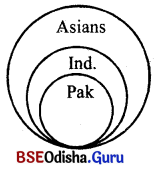
We can see in the above diagram the class extremes, neither by Indians nor by PakistAnswer: So the conclusion gets wrong.
Question 8.
Prove : Major premise must be universal in the first figure.
Answer:
One of the special syllogistic rule of the figure (one) says that major premise must be universal. But if the major premise be not universal in the 1 st figure then it must be particular. If the major premise is particular then in that case the middle term (m), which is the subject cannot be distributed. So the fallacy of “undistributed middle” will arise. But in order to avoid the fallacy of undistributed middle, it must be distributed in the minor premise, where the middle term is predicate. So if we will take minor premise as a negative proposition then it will distribute its predicate and the fallacy of undistributed middle will never occurs.
Again it we take minor premise as Negative proposition (E/o) then in that case major premise will be affirmative and the conclusion will be Negative. If the conclusion will be negative, it will be distribute its major term (P) which will never be distribute in case of the major premise. Because major premise as affirmative cannot be distributed is predicate. So we commit the fallacy of illicit major.
Again we can avoid the fallacy if illicit major if the major term (P) will be distributed in the major premise. If means if the major premise will be negative proposition, it will distribute its predicate (P). But we cannot take any negative proposition in case of the major premise. Because we have already taken the negative proposition in case of minor premise. All the above fallacies arise as we have taken the major premise as particular. So it proved that the major premise must be universal in the first figure.
Question 9.
Prove the following :
(a) Minor Premise must be affirmative in the 1st figure.
(b) ‘O’ proposition cannot be a premise in the 1st figure.
Answer:
(a) The minor Premise must be affirmative in the 1st figure : If the minor premise be not affirmative in the 1st figure then it must be negative. If the minor premise be negative then in that case the major is affirmative. So if the major affirmation and minor is negative, then conclusion must be negative and if the conclusion is a negative proposition it will always distribute its major term (P) which will never distribute in case of major premise as we have taken the major premise is affirmative. So the fallacy will arise, which is called illicit major.
Again this fallacy of illicit major can be avoided if we take the major premise as negative proposition. But we can not take the major into a negative. Because we have taken the minor premise as negative. So form this above discussion it is proved that the minor premise of the first figure must be affirmative but it cannot be negative.
(b) If one premise be O, the other premise must be A, and the conclusion must be O. So the mood is either O A o or AGO. In first figure, both these moods are universal.
O = Some M is not P.
A = All S is M.
∴ O = Some S is not P.
Here, the middle term is not at all distributed. So, it commits the fallacy of undistributed Middle.
A = All M is P.
O = Some S is not M.
∴ O = Some S is not P.
Here, the major term is distributed in the conclusion, but not distributed in the major premise. So it commits the fallacy of Illicit major. Therefore, O cannot be a premise in First figure.
Question 10.
Prove : Major premise must be universal in the first figure.
Answer:
One of the special syllogistic rule of the figure (one) says that major premise must be universal. But if the major premise be not universal in the 1 st figure then it must be particular. If the major premise is particular then in that case the middle term (m), which is the subject cannot be distributed. So the fallacy of “undistributed middle” will arise. But in order to avoid the fallacy of undistributed middle, it must be distributed in the minor premise, where the middle term is predicate. So if we will take minor premise as a negative proposition then it will distribute its predicate and the fallacy of undistributed middle will never occurs.
Again if we take minor premise as Negative proposition (E/o) then in that case major premise will be affirmative and the conclusion will be Negative. If the conclusion will be negative, it will be distribute its major term (P) which will never be distribute in case of the major premise. Because major premise as affirmative cannot be distributed is predicate. So we commit the fallacy of illicit major.
Again we can avoid the fallacy if illicit major if the major term (P) will be distributed in the major premise. If means if the major premise will be negative proposition, it will distribute its predicate (P). But we cannot take any negative proposition in case of the major premise. Because we have already taken the negative proposition in case of minor premise. All the above fallacies arise as we have taken the major premise as particular. So it is proved that the major premise must be universal in the first figure.
11. Explain :
(a) If the conclusion is universal the middle term can be distributed only once.
(b) If the major term in predicate in the major premise, the minor premise must be affirmative.
Answer:
(a) If the conclusion is universal, it is either A or E. In case of A, both the premises are A and only two terms are distributed in the premises. One of them must be the minor term, otherwise there arises the fallacy of illicit minor. So only one term is left distributed for the middle term.
In case of ‘E’, the premises are either EA or AE and three terms are distributed in the premises. Two of these must be the minor and the major terms to avoid the fallacies of the illicit process. So only one term is left distributed for the middle term.
Therefore, when the conclusion is universal the middle term can be distributed only once.
(b) The major term in the major premises if either distributed or undistributed. If it is distributed, then the major premise must be negative. So, in this case, the minor premise must be affirmative. If it is undistributed, then it cannot be distributed in the conclusion and the conclusion must be affirmative. If the conclusion be affirmative, then both the premises must be affirmative.
Therefore, if the major term is predicate in the major premise, the minor premise must be affirmative.
Question 12.
Prove : In the second figure major premise must if ‘I’ a universal and one premise must be negative.
Answer:
The proposition of the middle term in 2nd figure is :
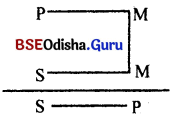
Thus in the second figure the middle term is the predicate in both the premise. Now affirmative proposition do not distribute their predicates but the middle term must be distributed at least once. So there must be a negative premise.
Question 13.
Explain. ‘O’ proposition can not be a major premise in the 4th figure.
Answer:
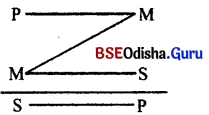
If we take ‘O’ proposition as a premise in figure IV, the other premise must be affirmative. In this case the conclusion will be particular negative (O). Which will always distribute its predicate term or major term (P). But the major term (P) will never distribute in case of the major premise. Because we have taken it as particular proposition, which will never distribute. Major term (P); as a result of which we commit the fallacy of illicit major. So it is proved that O proposition cannot be taken as a premise in figure IV.
Question 14.
Prove the following :
(a) Minor premise is affirmative in the 3rd figure.
(b) Conclusion is particular in the 3rd figure.
(c) At least one premise must be universal in the 3rd figure.
Answer:
(a) One of the special Syllogistic rule of the fig 3 says that minor premise must be affirmative in the 3rd figure. But the major premise be not affirmative then it must be negative. This case the major premise will be affirmative. If it be so then conclusion must be negative, but if the conclusion is negative then it will always distribute its predicate term, which will never distribute in case of the major premise. As a result which we will commit the fallacy of illicit major. So it is proved that minor premise must be affirmative in the 3rd figure.
(b) This rule says that conclusion must be particular in the 3rd figure. But if the conclusion be not particular then it must be universal (A/E). But if the conclusion be universal then the premise will also be universal. But if the conclusion be universal then it will be E proposition, which will distribute its subject term and predicate term. But however may be the predicate term will never be distribute in case of the major premise. As a result of which we will commit the fallacy of illicit major. So it is proved that the conclusion must be particular but should not be universal.
(c) If one of the premises be not universal in the 3rd figure then either both the predicate may be universal or may be particular. If both the premises are particular then no conclusion will follows as per the rule no 8. From two particular premises no conclusion follows. But if both the premises are universal the conclusion will be universal which will commonly distribute its subject term (minor) but it will never distribute in case of the minor premise. So we will commit the fallacy of illicit minor. From this above discussion it is proved that at least one premise must be universal.

Question 15.
Prove the following :
(a) If the conclusion is universal, the middle term can be distributed only once.
(b) If the major term is predicate in the major premise, the minor premise must be affirmative.
Answer:
(a) If the conclusion is universal, it is either A or E.
In the case of A, both the premises are A and only two terms are distributed in the premises. One of them must be the minor term, otherwise there arises the fallacy of illicit Minor. So only one term is left distributed for the middle term.
In the case of E, the premises are either EA or AE and three terms are distributed in the premises. Two of these must be the minor and the major terms to avoid the fallacies of the Illicit Process. So only one term is left distributed for the middle term. Therefore, if the conclusion is universal, the middle term can be distributed only once.
(b) The major term in the major premise is either distributed or undistributed. If it is distributed, then the major premise must be negative. So, in this case, the minor premise must be affirmative. If it is undistributed, then it cannot be distributed in the conclusion and the conclusion must be affirmative. If the conclusion be affirmative, then both the premise must be affirmative. Therefore, if the major term is predicate in the major premise, the minor premise must be affirmative.
Question 16.
Prove the following :
(a) No term will be distributed in the conclusion, if it is not distributed in the premises.
(b) In the fourth figure, if the major premise is O affirmative, the minor premise must be universal.
Answer:
(a) In deductive reasoning the conclusion. Can not be more general than the premises. A term is not distributed in the premises means only a part of the denotation is covered. But if it is distributed in the conclusion, that means we have drawn a conclusion on entire denotation based on part of denotation is a passage from “all” to “some”. Violation of this rule leads to two fallacies.
If the major term is distributed in the conclusion without being distributed in the major premise, it commits the fallacy of Illicit major For example
A-All tigers are animals
E-No. birds are tigers
E-No birds are animals
In the above example the major term “animal” is distributed in the conclusion but not in the premise. Secondly, if the minor term is distributed in the minor premise, it commits the fallacy of Illicit minor, for Example:
A-All snakes are poisonous
A-All snakes are reptiles
∴ A-All reptiles are poisonous
Here the minor term ‘reptiles’ is the predicate of ‘A proposition and so undistributed. But “reptile” is the subject of ‘A’ proposition in the conclusion and distributed. The argument is invalid.
(b) In the fourth figure, the middle term is the predicate in the major premise and subject in the minor premise. As affirmative propositions do not distribute their predicates, the middle term remains undistributed in the major premise. To avoid the fallacy of undistributed middle, it must be distributed in the minor premise, where it is the subject. Only universal propositions distribute their subjects. So, if the major premise is affirmative, the minor premise must be universal in the fourth figure.
Question 17.
Reduce ‘CAMENES’ both directly and indirectly.

Answer:
Direct Reduction of ‘CAMENES’
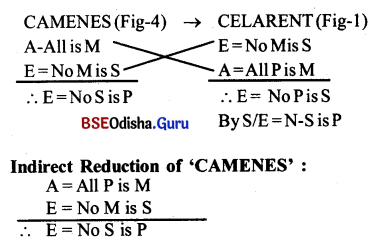
Let’s take the original conclusion of ‘CAMENES’ as false and its contradiction (I = Some S is P) as true. As per the rules of indirect reduction, here let’s take the major premise as true and minor premise as false. Here we should take the contradiction of the original conclusion as a true premise in the minor premise of ‘CAMENES’ which we have taken as false. After taking the value of major premise and minor premise as (true and false) let’s construct the new form of syllogism.

From this above it is said that ‘CAMENES’ is directly reduced to ‘CELARENT’ and indirectly reduced to DAR II.
Question 18.
Reduce ‘BOCARDO’ both directly and indirectly.
Answer:

Direct reduction of ‘BOCARDO’ BOCARDO (Fig-III) → DAR 99 (Fig-I) (Renamed as DOKSAMOSK)
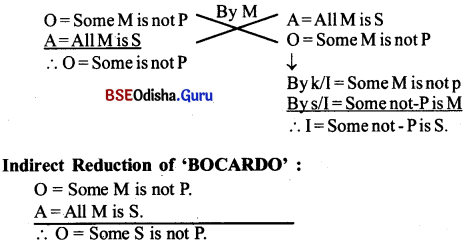
Let’s take the original conclusion as false (F) and its contradiction as true (T) (A = All S is P). Taking this new proposition as the major premise and the original as the major premise and the original minor as minor premise, let’s form a new syllogism.
A = All S is P.
A = All M is S
∴ A = All M is P
Now we can see that the new conclusion is the contradictory of the original major premise. Both cannot be true. One must be false. The original major premise cannot be false because in deductive reasoning the premises are always taken to be true. So the new conclusion is false. The falsity can arise out of two ways.
If we have violated the rules syllogism or there is mistake in the premises. But we have not violated the rules of syllogism for which it is the valid mood ‘BARBARA’ of the perfect 1st figure. So the mistake is in the premises. The minor premise cannot be false as it is the original minor premise. So the mistakeis in the major premise which is the contradictory of the original conclusion. So the original conclusion is proved to be true.
Question 19.
Reduce ‘CAMESTRES’ both directly and indirectly.

Answer:
Direct Reduction of CAMESTRES
CAMESTRES (Fig-2) → CELARENT (Fig = I)
A = All p is M By M
E = No S is p
∴ E = No S is p
E = No S is M
By s/E E = No M is S
A = All P is M
∴ E = No P is S
By s/E = No is P
Indirect reduction of CAMESTRES :
A = All P is M
E = No S is M
∴ E = No S is P
‘Let’s take the original conclusion of ‘CAMESTRES’ as false and its contradiction as true I = Some S is P). Taking this new proposition as the minor premise and the original major as the major, Let’s form a new syllogism.
A = All P is M
I = Some S is P
∴ I = Some S is M
Now we see that the new conclusion is the contradictory of the original minor premise. Both cannot be false: The original major premise cannot be false, because in the deductive reasoning premises are always taken to be true. So the new conclusion is false. The falsity can arise out of two ways. If we have mistake in the premises or if we have violated the rules of syllogism. We have not violated the rules of syllogism for which it is the valid mood ‘DAR99’ Of first figure. SO there is mistake in the premises. The major premise cannot be false because it is the original major premise. So the mistake is in the minor premise which is the contradictory of the original conclusion. So the original conclusion in true. From the above it is said that ‘CAMESTRES’ is directly reduce to ‘CELARENT’ and indirectly reduced to DAR99.
Question 20.
Reduce ‘FELAPTON’ both directly and Indirectly.
Answer:
Direct Reduction of FELAPTON. FELAPTON (Fig-3) → FER90 (Fig-1)
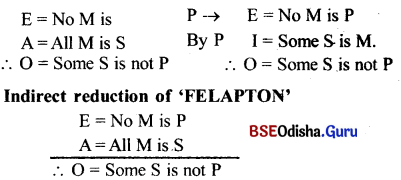
Let’s take the original conclusion of FELAPTON as false and its contradiction as true (All S is P), Taking this new’ proposition as the major premise and the original minor as the minor, Let’s form a new syllogism.

Now we see that the new conclusion is the contrary of the original major premise. Both cannot be true. One must be false. The original major premise cannot be wrong because in deductive reasoning premises are always taken to be true. So the new conclusion is false. The falsity can arise out of two ways. It there is any mistake in the premises or if we have violated the rules of syllogism. We have not violated the rules of syllogism for which it is the valid mood ‘BARBARA’, of first figure. So these is mistake in the premises. The minor premise cannot be false as if in the original minor. So the major premise is wrong. If it is wrong then its contradictory .the original conclusion in true.
Question 21.
Reduce ‘BRAMANTIP’ both directly and indirectly.
Answer:
Direct reduction of BRAMANTIP BRAMANTIP (Fig-4) → BARBARA (Fig = I)
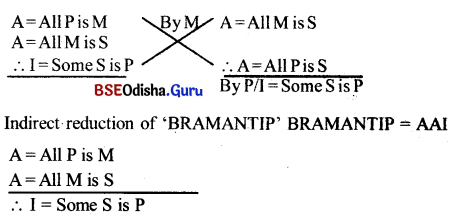
Let’s take the original as false and its contradiction as true. (E = No’S is P). Taking this new proposition as the major premise and the original minor as the minor, let’s form a new syllogism.

Now we see that the new conclusion is the contrary of the original major premise. Out of two premises, one must be false. The original major premise cannot be false because in deductive reasoning premises are always taken to be true. So the new conclusion is false. The falsity can arise out of two ways. It we have mistake in the premises or if we have violated the rules of syllogism.
We have not violated the rules of syllogism for which it is the valid mood ‘CELARENT’ of the perfect first figure. So there is mistake in the premises. The minor premise cannot be false as it is the original minor premise. So the mistake is in the major premise which is the contrary of the original conclusion. So the original conclusion is proved to be true. From this above it is said that BRAMANTIP is directly reduced to BARBARA and indirectly reduced to CELARENT.
Question 22.
Reduce ‘FESAPO’ both directly and indirectly.
Answer:
Direct Reduction of ‘FESAPO’
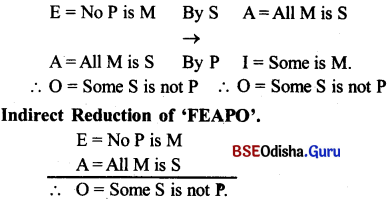
Suppose this conclusion is false. If it is false, its contradictory ‘A’ = All is S is P in true. Taking this new proposition as the major premise and the original minor as the minor, let’s form a new syllogism;

Now we see that the converse of the new conclusion is the contradictory of the original major premise. Both cannot be true. One must be false. The original premise cannot be false as in the deductive reasoning the premises are always taken to be true. So the new conclusion is false. The falsity can arise out of two ways. If there is mistake in the premises or if we have violated the rules of syllogism. We have not violated the rules of syllogism for which it is the valid mood BARBARA’ of 1st figure. So the mistake is in the premises. The minor premise cannot be wrong beca use it is the original minor premise. So the major premise is false which is the contradictory of the original conclusion. So the original conclusion is proved to be true.
Question 23.
Reduce ‘FESTINO’ both directly and indirectly.
Answer:
Direct Reduction of FESTINO
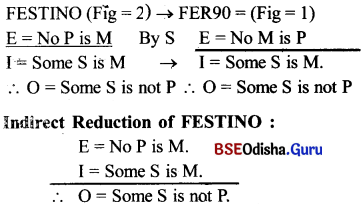
Let’s take the original,conclusion as false and its contradiction (A = All S is P) as true. Taking this new proposition as# the minor premise and the original major as the major, let’s form a new syllogism.

Here we see that the new conclusion in the contradictory of the original minor premise. Both cannot be true. One must be false. The original minor premise cannot be false as in deductive reasoning the original premises are always taken to be true. So the new conclusion is false. This falsity can arise out of two ways. If there is any mistake in the premises or if we have violated the rules of syllogism. We have not violated the rules of syllogism for which it is the valid mood CELARENT of 1st figure. So there is mistake in the premises. The major premise cannot be wrong as it is the original major. So the mistake is in the minor premise. If the minor premise is false, then its contradictory the original conclusion is true.

Question 24.
Explain Aristotle’s Dictum and determine its role in reduction.
Answer:
Aristotle, the father of deductive Logic, has formulated a rule in order to test the validity of syllogistic arguments, that is the fundamental principle of syllogism known as “Dictum de omni et nullo”, which means “Statement concerning all and none”.

Now we can see that the new conclusion is the contradictory of the original minor premise. Both can not be true. One must be false. In deductive syllogism premises are always taken to be true. So the new conclusion is false. The falling can arise out of two ways, if there is mistake in the premises or if we have violated the rules of syllogism. We have not violated the rules of syllogism for which it is the valid mood FERIO of 1st figure. So the mistake is in the premises. The major premise can not be wrong because it is the original major premise. So the falsity lies in the minor promise. If the minor premise is wrong, its contradictory, the original conclusion is true.
Question 25.
Reduce ‘BAROCO’ both directly and indirectly.
Answer:
DIRECT REDUCTION OF “BAROCO” BAROCO (FAKSOKO) → FERIO
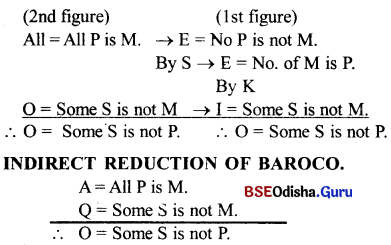
Suppose the conclusion is false, It’s false, its contradictory “A = All is P” is true. Taking this new proposition as the minor premise and the original major as the major, lets form a new Syllogism.

Now we can see that the new conclusion is the contradictory of the original minor premise. Both cannot be true. One must be false. In deductive reasoning the premises are always taken to be true. So the new conclusion is false. The falsity can arise out of two ways. If there is any mistake in the premises or if we have violated the rules of syllogism.
We have not violated the rules of syllogism for which it is the valid mood ‘BARBARA’ of 1 st figure which is the perfect figure. So the mistake is in the premises. The major premise cannot be wrong as it is the original major premise. So the mistake is the minor premise which is the contradictory of the original conclusion. So the original conclusion is proved to be true. From the above it is said that ‘BAROCO’ is directly reduced to FERIO and indirectly reduced to BARBARA.
Question 26.
Reduce ‘DATISI’ both directly and indirectly.
Answer:
DIRECT REDUCTION OF ‘DATISI’
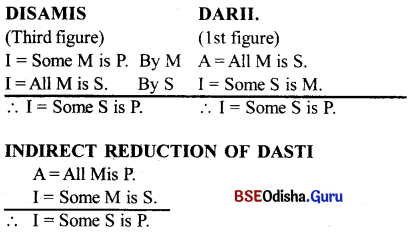
In the above valid mood let’s take the original conclusion “I = Some S is P” is false (F) and its contradiction ‘E’ = No S is P” is true. As per the rules of indirect reduction. Let’s take the original major true (T) and minor premise “I = Some M is S” as false (F). Here we should take the contradiction form of the original conclusion, in case of the minor premise, which we have taken as False.
Let’s construct the new form of Syllogism.

From the above it is proved that ‘DASTI’ is directly reduced to ‘DARIF and indirectly reduced to CAMESTRES.
Question 27.
Reduce ‘DISAMIS’ both directly and indirectly.
Answer:
DIRECT REDUCTION OF ‘DISAMIS’.
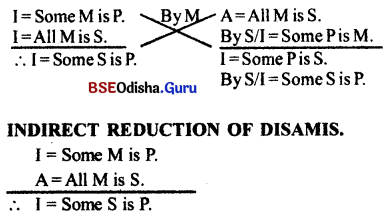
Suppose the conclusion is false. If it is false, its contradictory ‘E = No S is P’ is true. Taking this new proposition as the major premise and the original minor as minor, Let us a new syllogism

Now we can see that the new conclusion is the contradictory of the original major premise. Both cannot be true. One must be false. The original major premise cannot be wrong because in deductive reasoning premises are always taken to be true. So the new-conclusion is false. The falsity can arise out of two ways. It there is mistake in the premises or if we have violated the rules of syllogism.
We have not violated the rules of syllogism for which it is the valid mood ‘CELARENT’ of the perfect first figure. So the mistake is in the premises. The minor premise cannot be false because it is the original minor premise. So the mistake is in the major premise which is the contradictory of the original conclusion. So the original conclusion is proved to be true. From this above it is said that ‘DISAMIS’ is directly reduced to ‘DARII’ and indirectly reduced to “CLEARENT”.
Question 28.
Reduce “FRESISON” both directly and, indirectly.
Answer:
DIRECT REDUCTION OF “FRESISON”
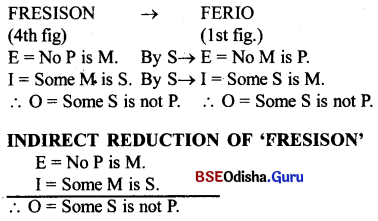
Suppose the original conclusion is false. It is false. If it is false, its contradictory “A = All S is P” must be true. Taking this new proposition as the minor premise and the original major premise as the major, Let us form a new syllogism:

This is ‘CELARENT’ of first figure and ‘p’ as the middle term. Now we see that the converse of the new conclusion is the contradictory of the original minor premise. So both cannot be true together. One must be false. The original minor premise cannot be false as inductive reasoning the original premises are always taken to be true. So the new conclusion and its converse is false. Falsity can arise out of two ways. If there is any mistake in the premises or if we have violated the rules of Syllogism.
We have not violated the rules for which it is the valid mood “CELARENT” of first figure and its converse. So there is mistake in the premises. The major premise cannot be wrong as it is the original major. So the mistake is in the minor premise. If the minor premise is false, then its contradictory, the original Conclusion ‘O’ = some S is not P must be true. Thus ‘FRESISON” is a valid mood of Fourth figure.
From this above it is said that ‘FRESISON’ is directly reduced to ‘FERIO’ and indirectly reduced to CELARENT.
Question 29.
Show that obversion and simple conversion give equivalent conclusions, but partial conversion gives a non-equivalent conclusion.
Answer:
A conclusion is equivalent, if by repeating the same Logical process we obtain the original proposition. It is non-equivalent, if we cannot come back to the original proposition by the repetition of the inferential process. Obversion :
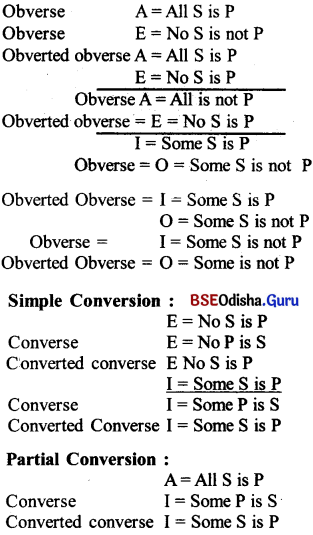
Question 30.
Prove : Major premise must be universal in the A, first figure
Answer:
One of the special Syllogistic rule of the figure (one) says that major premise must be universal. But if the major premise be not universal in the first figure then it must be particular. If the major premise is particular then in that case the middle term (M) which is the subject cannot be distributed. So the fallacy of “undistributed middle” will arise. But in order to avoid the fallacy of undistributed middle, it must be distributed in the minor premise, where the middle term is predicate. So if we will take minor premise as a negative proposition then it will distribute its predicate and the fallacy of undistributed middle will never occur.
Again if we take minor premise as Negative proposition (E/O) then in that case major premise will be affirmative and the conclusion will be negative, it will be distribute its major term (P) which will never be distribute in case of the major premise. Because major premise as affirmative cannot be distributed its predicate. So we commit the fallacy of illicit major. Again we can avoid the fallacy of illicit major if the major term (P) will be distributed in the major premise.
It means if the major premise will be negative proposition, it will distribute. Its predicate (P). But we cannot take-only negative proposition in case of the major premise, Because we have already taken the negative proposition in case of minor premise. All the above fallacies arise as we have taken the major premise as particular. So it is proved that the major premise must be universal in the first figure.
Question 31.
Prove : Major premise must be universal in the 2nd figure.
Answer:
One of the special Syllogistic rule in the 2nd figure (2) says that major premise must be universal But if the major premise be not universal then it must be particular (10). Suppose if we will take major premise as 1 then in the case the middle term will never distribute. So we will take minor premise as ‘E’ proposition. Then the conclusion will be ‘O’ which will always distribute its predicate but will never distribute in case of the major premise, as a result of which we will commit the fallacy of illicit major.
Again it will take major premise as ‘0’ and minor premise as ‘A’ then the conclusion will be ‘O’. If it be so then in the case the major term will be distribute. Which will never distribute in case of major premise and automatically we will commit the fallacy of illicit major. From this above discussion this proved that major premise must be universal in 2nd figure.
Question 32.
Prove the Special Syllogistics rules of 4th figure.
Answer:
(a) If the major premise is affirmative, the minor premise must be universal:
If the major premise is affirmative, it does not distribute it predicate, i.e., the middle term. To avoid the fallacy of undistributed middle, the middle term must be distributed in the minor premise, where it is the subject. So in this case, the minor premise must be universal.
(b) If any premise is negative, the major premise must be universal:
If any premise is negative, the conclusion must be negative and the major term is distributed in the conclusion. To avoid the fallacy of illicit major, the major term must be distributed in the major premise where it is the subject. So in this case, the major must be universal.
(c) Both the premise cannot be negative : If both the-premises are negative no conclusion follows. This is one of the general Syllogist rules. It is started as a special Syllogistic rule of figure IV. In order to make the special Syllogistic rules self-sufficient to determine, the valid mood of this figure.
(d) If the major premise is affirmative, the conclusion is particular. If the minor premise is affirmative, the minor term is not distribute in the minor premise, consequently it can not be distributed in the conclusion, where it is the subject. So, in this case, the conclusion must be particular.

Question 33.
Prove the following :
(a) The middle term cannot be distributed twice in figure I & figure II.
(b) ‘O’ proposition can not be a premise in figure ‘IV’.
Answer:
(a) The position of the terms in fig 1 is :
M P
S M
∴ S P
If the middle term is distributed twice, then the major premise is universal and. the minor premise is negative. The minor premise being negative, the conclusion must be negative and the major premise must be affirmative. In that case, the major term is distributed in the conclusion, but not distributed in the major premise leading to the fallacy of illicit major. So, the middle term cannot be distributed twibe ill Fig. 1.
The Position of the terms in Fig. II is :
P M
S M
∴ S P
If the middle term is distributed twice, then both the premises are negative and no conclusion follows. So, the middle term cannot be distributed twice on Fig. II.
(b) It one premise be 0, the other premise must be A, and the conclusion must be 0. So, the mood is either OAO or AOO in fig I both these moods are invalid.
O – Some M is not P.
A – All S is M.
O – Some S is not P.
Here, the middle term is not at all distributed. So it commits the fallacy of Undistributed Middle.
A – All M is P.
O – Some S is not M.
∴ O – Some S is not P.
Here the major term is distributed in the contusion, but not distributed in the major premise. So, it commits the fallacy of Illicit Major, Therefore O cannot be a premise in Fig.l.
Question 34.
Prove the following :
(a) If in a Syllogism only two terms are distributed twice, the conclusion must be ‘O’.
(b) If in the minor term in predicate in the minor premise the conclusion cannot be ‘A’.
Answer:
(a) Here, of the two distributed terms, one must be the middle term to avoid the fallacy of Undistributed Millde. If the millde term is distributed twice, the conclusion must be particular; i.e., I or O. If is 1, neither the minor nor the major term can be distributed. So the condition ‘two terms distributed twice’ cannot be fulfilled. Thus the only possibility left is that the conclusion is O. The premises, here, are EA and the mood is EAO.
(b) The minor term in the minor premise is either distributed or undistributed. If it is distributed, the minor premise is negative. So, the conclusion cannot be affirmative, i.e. the conclusion cannot be A. If it is undistributed, it cannot be distributed in the conclusion. So the conclusion cannot be universal, i.e. the conclusion cannot be A. Thus, if the minor term is predicate in the minor premise, the conclusion cannot be A.
Question 35.
Why ‘El’ is valid in every figure, but ‘IE’ is valid in None.
Answer:
The major premise ‘E’ distributes the major term and the middle term whatever be their positions. The minor premise does not distribute the middle term, whatever be its position, in whatever figure the argument may be, the distributed and undistributed terms remain the same. The distributed and undistributed terms are adequate to justify the conclusion = 0. where the minor term is undistributed and the major terms is distributed. The rules regarding the quality and quantity are also not violated, if the conclusion in 0. So ‘EIO’ is valid mood in all figures. It is called FERIO in figure one, FESTINO in figure TWO, FERISON in figure three and FRESISON in figure four.
The major premise T does not distribute the major term, whatever be its position. The negative minor premise leads to a Negative conclusion, which distributed its major term. So, we commit the fallacy of illicit major, whatever be the figure of syllogism. So, TEO’ is not valid in any figure.
Question 36.
Reduce ‘CESARE’ both directly and indirectly.
Answer:
Direct Reduction of ‘CESARE’
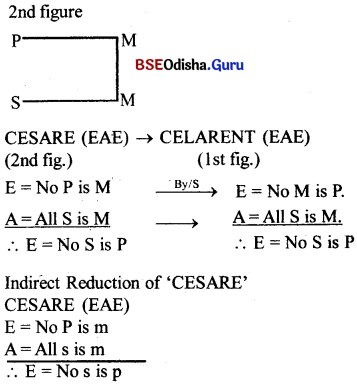
In the above imprefect mood (CESARE) let’s first take the original conclusion (E = N o S is p) as false and its contradiction (I = some S is P) as true. As per the rales of indirect reduction let’s take major premise of CESARE as true and minor premise of CESARE as false. Let’s take the contradiction of the conclusion (I = some S is P) as a new premise in case of the minor premise of ‘CESARE’ which we have taken as false. By taking the major premise of ‘CESARE’ E = No P is M and minor premise I = some S is P, let’s construct the new form of syllogism.

From the above it is said that ‘CESARE’ is directly reduced to CELARENT and indirectly reduced to FERIO.
Question 37.
Reduce ‘DARASPTP both directly and indirectly.
Answer:
Direct Reduction of ‘DARAPTI’
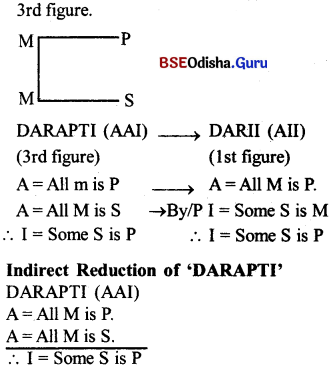
In the above imperfect mood (DARAPTI), Let’s first take its original conclusion (I = Some S is P) as false and its contradiction (E = NO S is P) as true.
As per the rales of indirect reduction let’s take the major premise of DARAPTI as false and minor premise as true. Let’s take the contradiction (E = NO S is P) of the original conclusion as a new premise in case of the major premise of DARAPTI, which we have taken as false. By taking the major premise of DARAPTI as I = Some S is P and minor premise of DARAPTI as A = All M is S, Let’s construct the new form of syllogism.

From the above it is said that ‘DARAPTE is directly reduced to ‘DARIE and indirectly reduced to CELARENT.
Question 38.
Reduce ‘FERISON’ both directly and indirectly.
Answer:
Direct Reduction of ‘FERISON’
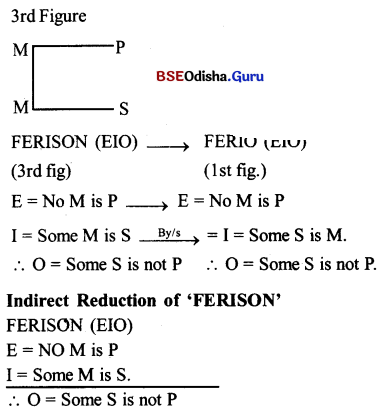
In the above imperfect mood (FERISON), Let’s first take the original conclusion (O = Some S is not P) as false and its contradiction.
(A = All S is P) as true.
As per the rules of indirect reduction let’s take the major premise of FERISOn (E = No M is P) as false and the minor premise of FERISON (I = Some M is S) as true. Let’s take the contradiction form (A = All S is P) of original conclusion as a new premise in case of the major premise of FERISON, which we have taken as false.
By taking the major premise of ‘FERISON’ as (A = All S is P), minor premise of FERISON ad (I = Some M is S) true, Let’s construct the new form of syllogism.

From the above it is said that FERISON is directly reduced to ‘FERIO’ and indirectly reduced to ‘DARII’.
Question 39.
Reduce ‘DIMARIS’ both directly and indirectly.
Answer:
Direct Reduction of ‘DIMARIS’
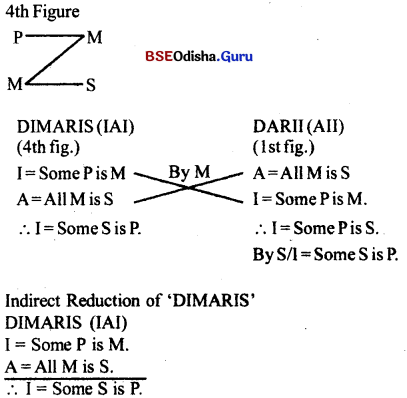
In the above imperfect mood DIMARIS, let’s take first the friginal conclusion (I = Some S is P) as false and its contradiction form (E = No S is P) as true.
As per the rules of indirect reduction, let’s take the major premise of DIMARIS as false and minor premise of DIMARIS as true. Let’s take the contradiction form of the conclusion as a new premise in case of the major premise of ‘DIMARIS’ which we have taken as false.
By taking major premise as (E = No S is P) and minor premise as (A = All M is S), let’s construct the new form of syllogism.

From the above it is said that ‘DIMARIS’ is directly reduced to ‘DARII’ and indirectly reduced to ‘CELARENT’.
Group – C
I. Multiple Choice Questions with Answers :
Question 1.
Syllogism is:
(i) An immediate inference
(ii) A mediate inference
(iii) Both immediate and mediate inference
(iv) None of these
Answer:
(ii) A mediate inference
Question 2.
Pick the odd man out:
(i) Major term
(ii) Minor term
(iii) Middle term
(iv) Equivocal term
Answer:
(iv) Equivocal term
Question 3.
The middle term must be distributed in the premises :
(i) Once
(ii) Twice
(iii) Ateast once
(iv) None of these
Answer:
(iii) Ateast once
Question 4.
In which figure the middle term take the position of the subject in both the premises?
(i) Figure-I
(ii) Figure-II
(iii) Figure-III
(iv) Figure-IV
Answer:
(iii) Figure-III
Question 5.
How many moods are possible in each figure by considering the quality and quantity of only premises?
(i) 16
(ii) 19
(iii) 64
(iv) 256
Answer:
(i) 16
Question 6.
A term which is ret distributed in the premise of a syllogism :
(i) May be distributed in the conclusion
(ii) May or may not be distributed in the conclusion
(iii) Must be distributed in the conclusion
(iv) Must not be distributed in the conclusion
Answer:
(iv) Must not be distributed in the conclusion
Question 7.
From two negative premises, we derive :
(i) A valid conclusion
(ii) An invalid conclusion
(iii) Either a valid or an invalid conclusion
(iv) None the these
Answer:
(ii) An invalid conclusion
Question 8.
Which figure has not weakened moods?
(i) Figure-I
(ii) Figure-II
Answer:
(iii) Figure-Ill
Question 9.
Which of the following is not a weakened mood ?
(i) Barbari
(ii) Camestros
(iii) Darapti
(iv) Camenos
Answer:
(iii) Darapti
Question 10.
In which of the following figures in the AA combination of premises not valid?
(i) Figure-I
(ii) Figure-II
(iii) Figure-III
(iv) Figure-IV
Answer:
(ii) Figure-II

Question 11.
A syllogism is invalid if:
(i) Both the premises are universal
(ii) Both the premises are affirmative
(iii) Both the premises are negative
(iv) One of the premises is negative
Answer:
(iii) Both the premises are negative The mood ‘AAF’ is invalid in :
(i) Figure-I
(ii) Figure-II
(iii) Figure-Ill
(iv) Figure-IV
Answer:
(ii) Figure-II
Question 12.
The mood ‘AAF’ is invalid in:
(i) Figure-I
(ii) Figure-II
(iii) Figure-III
(iv) Figure-IV
Answer:
(ii) Figure-II
Question 13.
Which combination of premises is valid in all figures ?
(i) AA
(ii) AE
(iii) EA
(iv) El
Answer:
(iii) EA
Question 14.
How many propositions are there in syllogism?
(i) Three
(ii) Four
(iii) Five
(iv) Two
Answer:
(i) Three
Question 15.
How many premises are there in syllogism ?
(i) Three
(ii) Four
(iii) Two
(iv) Five
Answer:
(iii) Two
Question 16.
How many terms are there in syllogism?
(i) Two terms
(ii) Three terms
(iii) Four terms
(iv) Five terms
Answer:
(ii) Three terms
Question 17.
The first proposition of a syllogism is called :
(i) Minor premise
(ii) Major Premise
(iii) Conclusion
(iv) None of these
Answer:
(ii) Major premise
Question 18.
The second proposition of a syllogism is called :
(i) Major premise
(ii) Conclusion
(iii) Minor premise
(iv) Conclusion
Answer:
(iii) Minor premise
Question 19.
The third proposition of a syllogism is called.
(i) Major premise
(ii) Minor premise
(iii) Conclusion
(iv) Middle term
Answer:
(iii) Conclusion
Question 20.
The first premise of syllogism is called:
(i) Major premise
(ii) Minor premise
(iii) Conclusion
(iv) None of these
Answer:
(I) Major premise
Question 21.
The second premise of syllogism is called:
(i) Major premise
(ii) Minor premise
(iii) Conclusion
(iv) None of these
Answer:
(i) Minor premise
Question 22.
Hoe many general syllogistic rules are there?
(i) Ten
(ii) Nine
(iii) Eight
(iv) Seven
Answer:
(i) Ten
Question 23.
How many figures are there in syllogism?
(i) Five
(ii) Six
(iii) Four
(iv) Eight
Answer:
(iii) Four
Question 26.
What is the position of middle term in the second figure?
(i) Subject in both the premises
(ii) Predicate in both the premises
(iii) Subject in major and predicate in minor premise
(iv) Predicate in major and subject in minor premise
Answer:
(ii) Predicate in both the premises
Question 27.
What is the position of middle term in the third figure?
(i) Subject in both the premises
(ii) Predicate in both the premises
(iii) Subject in major and predicate in premise
(iv) Predicate in major and subject in premise
Answer:
(i) Subject in both the premises
Question 28.
What is the position of middle term in the fourth figure?
(i) Subject in both the premises
(ii) Predicate in both the premises.
(iii) Subject in major and predicate in minor premise
(iv) Predicate in major and subject in minor premise.
Answer:
(iv) Predicate in major and subject in minor premise.
Question 29.
Subject term of the conclusion of a syllogism is called which term?
(i) Major term
(ii) Minor term
(iii) Middler term
(iv) None of these
Answer:
(ii) Minor term
Question 30.
The predicate term of the conclusion of syllogism is called which term?
(i) Major term
(ii) Minor term
(iii) Middle term
(iv) Cannot say
Answer:
(i) Major term

Question 31.
The term which absent in the conclusion is called which term?
(i) Major term
(ii) Minor term
(iii) Middle term
(iv) None of these
Answer:
(iii) Middle term
Question 32.
There are two terms in major premise, one is major term other is:
(i) Minor term
(ii) Middle term
(iii) Major term
(iv) No other term is present
Answer:
(ii) Middle term
Question 33.
Which term must be distributed at atleast once in any of the premises?
(i) Major term
(ii) Minor term
(iii) Middle term
(iv) None of these
Answer:
(iii) Middle term
Question 34.
If the middle term is not distributed in any of the premises then we commit which fallacy?
(i) Illicit major
(ii) Undistributed Middle
(iii) Illicit minor
(iv) Four terms
Answer:
(ii) Undistributed Middle
Question 35.
If a syllogism is consisted of more than three terms then which fallacy arises?
(i) Illicit major
(ii) Four terms
(iii) Undistributed middle
(iv) Illicit minor
Answer:
(ii) Four terms
Question 36.
When the minor term is distributed in the conclusion without being distributed in the minor premise, we commit which fallacy?
(i) Undistributed middle
(ii) Four terms
(iii) Illicit minor
(iv) Illicit major
Answer:
(iv) Illicit major
Question 37.
When the minor term is distributed in the conclusion without being distributed in the minor premise, we commit which fallacy?
(i) Illicit major
(ii) Illicit minor
(iii) Fallacy of four terms
(iv) Undistributed middle
Answer:
(ii) Illicit minor
Question 38.
Is it correct to say that if both the premises are negative, the conclusion is negative?
(i) Yes
(ii) No
(iii) Partially correct
(iv) Cannot say
Answer:
(ii) No.
Question 39.
When we draw the conclusion out of two negative premises then we commit which fallacy?
(i) Fallacy of two negative premises
(ii) Fallacy of two particular premises
(iii) Fallacy of undistributed middle
(iv) No fallacy arises.
Answer:
(i) Fallacy of two negative premises
Question 40.
If both the premises are affirmative then the conclusion will be what?
(i) Affirmative
(ii) Negative
(iii) Particular
(iv) No conclusion
comes
Answer:
(i) Affirmative
Question 41.
If both the premises are particular then the conclusion will be what?
(i) Affirmative
(ii) Particular
(iii) Negative
(iv) No conclusion comes
Answer:
(ii) Particular
Question 42.
When the major premise be particular and minor premise be negative then the conclusion will be what?
(i) Affirmative
(ii) Negative
(iii) Universal
(iv) No conclusion will be follow
Answer:
(iv) No conclusion will be follow
Question 43.
If one of the premise be particular, the conclusion will be what?
(i) affirmative
(ii) universal
(iii) particular
(iv) none of these
Answer:
(iii) particular
Question 44.
Mood of the syllogism in mainly determined by :
(i) Quality of the premises
(ii) Quantity of the premises
(iii) Both quality and quantity of the premises
(iv) Position of the middle term.
Answer:
(iii) Both quality and quantity of the premises
Question 45.
According to first group of logicians, the number of possible moods of four different figures are:
(i) 16
(ii) 64
(iii) 256
(iv) 4
Answer:
(ii) 64
Question 46.
How many valid mood are in four different figures?
(i) 16
(ii) 64
(iii) 19
(iv) 225
Answer:
(iii) 19
Question 47.
How many valid moods are there in the first figure?
(i) Four
(ii) Three
(iii) Six
(iv) Eight
Answer:
(i) Four
Question 48.
How many valid moods are there in the second figure?
(i) Three
(ii) Four
(iii) Five
(iv) Six
Answer:
(ii) Four
Question 49.
How many valid moods are there in the third figure?
(i) Four
(ii) Five
(iii) Six
(iv) Eight
Answer:
(iii) Six
Question 50.
How many valid moods are in the 4th figure?
(i) Four
(ii) Five
(iii) Six
(iv) Eight
Answer:
(ii) Five

Question 51.
How many fundamental moods are there in syllogism?
(i) 15
(ii) 16
(iii) 18
(iv) 8
Answer:
(i) 15
Question 52.
How many strengthened moods are there in syllogism?
(i) 15
(ii) 16
(iii) 5
(iv) 8
Answer:
(iv) 8
Question 53.
How many weakened moods are there in syllogism ?
(i) five moods
(ii) six moods
(iii) eight moods
(iv) nine moods
Answer:
(i) five moods
II. Fill in the blanks :
Question 1.
Syllogism is a ______ kind of inference.
Answer:
mediate
Question 2.
A syllogism is consisted of _____ proposition .
Answer:
Three
Question 3.
A syllogism is consisted of _____ premises.
Answer:
Two
Question 4.
The two propositions from which the conclusion is drawn in a syllogism are called as _____
Answer:
Premises
Question 5.
The conclusion of a syllogism cannot be more _____ than the premises.
Answer:
general
Question 6.
The three terms in a syllogism occur _____ each in it.
Answer:
Twice
Question 7.
The term which occurs twice in the premises is called as the _____ term.
Answer:
middle
Question 8.
The first proposition of a syllogism is called _____ premise.
Answer:
Major
Question 9.
The second proposition of a syllogism is called _____ premise.
Answer:
Minor
Question 10.
The third proposition of a syllogism is called _____ .
Answer:
Conclusion
Question 11.
The three terms of a syllogism are called _____ and _____ .
Answer:
major, minor, middle term
Question 12.
The predicate of the conclusion is called _____ term.
Answer:
Major term
Question 13.
The subject of the conclusion is called _____term.
Answer:
Minor term
Question 14.
The premise in which the major term occurs is the _____ premise.
Answer:
Major
Question 15.
The premise in which the minor term occur is the _____ premise.
Answer:
Minor
Question 16.
The denotation of the major term is _____ than the denotation of the minor term.
Answer:
more
Question 17.
The symbol of the major term is _____
Answer:
‘P’
Question 18.
The symbol of the minor term is _____
Answer:
‘S’
Question 19.
The symbol of the middle term is _____
Answer:
M’

Question 20.
Syllogisms are of two kinds, namely, _____ and _____ Syllogisms.
Answer:
Pure, mixed
Question 21.
Figure of the syllogism is mainly determined by the position of _____ term.
Answer:
Middle
Question 22.
There are _____ figures in syllogism.
Answer:
Four
Question 23.
The figure _____ is called _____ figure
Answer:
First
Question 24.
In the 1st figure the middle term is _____
Answer:
Subject of the major premise and predicate in the minor premise.
Question 25.
In the second figure the middle term is _____.
Answer:
Predicate of both the premises.
Question 26.
In the third figure middle term is _____.
Answer:
subject of both the premises
Question 27.
In the fourth figure middle term is _____.
Answer:
Predicate of the major premise and subject of the minor premise.
Question 28.
There are _____ general syllogistic rules.
Answer: Ten
Question 29.
If a syllogism is consisted of more than three propositions, we commit _____ fallacy.
Answer:
Train of syllogism
Question 30.
If a syllogism is consisted of more than three terms, we commit the fallacy of _____.
Answer:
Four terms
Question 31.
Middle term must be _____ at least once in an of the premises.
Answer:
Distributed
Question 32.
When the middle term is not distributed in any of the premises we commit _____ fallacy.
Answer:
undistributed middle
Question 33.
When the major term (p) is distributed in the conclusion without being distributed in the major premise at that time _____ fallacy arises.
Answer:
Illicit major
Question 34.
When the minor term(s) is distributed in the conclusion without being distributed in the minor premise at that time we commit _____ fallacy.
Answer:
Illicit minor
Question 35.
If one of the premise be negative then other premise must be _____ .
Answer:
Affirmative .
Question 36.
If one of the premise be negative then the conclusion must be _____ .
Answer:
Negative
Question 37.
If both premises are negative then the conclusion will be _____ .
Answer:
inpossible
Question 38.
From two negative premises if the conclusion will be drawn then _____.
Answer:
The fallacy of two negative premises arises.
Question 39.
If both the premises are affirmative the conclusion will be _____.
Answer:
affirmative :

Question 40.
If both the premises are particular, the conclusion must be _____.
Answer:
particular
Question 41.
Out of two premises, if one premise be particular the conclusion will be _____.
Answer:
particular
Question 42.
From particular major and negative minor _____ conclusion comes.
Answer:
no
Question 43.
Mood of the syllogism is determined by the _____ and _____ if the premises.
Answer:
quality, quantity
Question 44.
According to the 1 st group of logicians, there are _____ moods in syllogism!
Answer:
64
Question 45.
According to second group of logicians there are _____ moods in syllogism.
Answer:
256
Question 46.
According to Aristotle, there are _____ types of valid moods in syllogism.
Answer:
19
Question 47.
The weakened or the sub-altern moods in figure one are _____ and _____.
Answer:
Barbari, celaront
Question 48.
The weakened or the sub-altern moods in figure one are _____ and _____.
Answer:
camestros, cesaro.
Question 49.
There is no sub-altern‘mood in _____.
Answer:
third
Question 50.
The sub-altern mood in figure four is _____.
Answer:
Camenos
Question 51.
Elina Loves Lipina.
Lipika loves Rani.
∴ Rani loves Elina.
Answer:
Four terms
Question 52.
‘BOCARDO’is the valid mood of _____ figure.
Answer:
third
Question 53.
‘DARAPTF’ is the valid mood of _____ figure.
Answer:
third
Question 54.
‘BRAMANTIP’ is the valid mood of _____ figure.
Answer:
Fourth
Question 55.
‘CAMENES’ is the valid mood of _____ figure.
Answer:
fourth
Question 56.
The other name of ‘BAROCO’ is _____ .
Answer:
FAKSOKO
Question 57.
‘DIMARIS’ is the valid mood of _____ figure.
Answer:
fourth
Question 58.
‘FESTINO’ is the valid mood of _____ figure.
Answer:
second
Question 59.
The other name of ‘BOCARDO’ is _____.
Answer:
DOKSAMOSK

Question 60.
Reduction is divided into _____ and _____.
Answer:
direct, indirect
Question 61.
In Reduction the letter ‘M’ means _____.
Answer:
Mutual transposition of the premises
Question 62.
In reduction the letter ‘S’ means _____.
Answer:
Simple conversion
Question 63.
In reduction the letter ‘P’ means _____.
Answer:
partial conversion
Question 64.
In reduction the letter ‘K’ means _____.
Answer:
obversion
Question 65.
‘CAMESTRES’ is directly reduced to _____.
Answer:
CELARENT
Question 66.
‘CESARE’ is directly reduced to _____.
Answer:
CELARENT
Question 67.
‘FESTINO’ is directly reduced to _____ .
Answer:
FERIO
Question 68.
“BAROCO” is directly reduced to _____ .
Answer:
FERIO
Question 69.
‘DARAPTF is directly reduced to _____.
Answer:
DARII
Question 70.
‘DATISI’ is directly reduced to _____ .
Answer:
DARII
Question 71.
‘DISAMIS’ is directly reduced to _____.
Answer:
DARII
Question 72.
FELAPTON is directly reduced to _____.
Answer:
FERIO
Question 73.
‘FERISON’ is directly reduced to _____.
Answer:
FERIO
Question 74.
‘BOCARDO’ is directly reduced to _____.
Answer:
DARII
Question 75.
‘BRAMANTIP’ is directly reduced to _____.
Answer:
BARBARA
Question 76.
‘CAMENES’ is directly reduced to _____.
Answer:
CELARENT
Question 77.
‘FESAPO’ is directly reduced to _____.
Answer:
FERIO
Question 78.
‘FRESISON’ is directly reduced to _____.
Answer:
FERIO
Question 79.
‘DIMARIS’ directly reduced to _____.
Answer:
DARIF
Question 80.
The process of proving the validity of the mood of the imperfect figures with the help of the perfect moods is called _____.
Answer:
Reduction

Question 81.
If the conclusion be ‘A’, the argument must be in _____.
Answer:
figure one
Question 82.
______ proposition cannot be a premise either in figure one or in figure four.
Answer:
‘O’ proposition
Question 83.
The middle term cannot be distributed twice in _____and _____.
Answer:
Figure one and figure two
Question 84.
Figure are _____ fundamental moods in syllogism.
Answer:
15
Question 85.
There are _____ strengthened moody in syllogism.
Answer:
8
Question 86.
There are _____ weakened moods in syllogism.
Answer:
five
Question 87.
If the conclusion is universal, the middle term can be distributed _____.
Answer:
only once
Question 88.
If the major term is predicate in the major premise, the minor premise must be _____.
Answer:
affirmative
Question 89.
If the middle term is distributed twice, the conclusion must be _____.
Answer: particular
Question 90.
In a syllogism if two terms are distributed twice, the conclusion must be _____.
Answer:
‘O’ proposition
Question 91.
If the minor term is predicate in the minor premise, the conclusion cannot be _____.
Answer:
‘A’ proposition
Question 92.
‘BAROCO’ is indirectly reduced to _____.
Answer:
BARBARA
Question 93.
BOCARDO’ is indirectly reduced to _____.
Answer:
CELARENT .
Question 94
‘DARAPTI’ is indirectly reduced to _____.
Answer:
CELARENT ,
Question 95.
‘DARAPTF’ is indirectly reduced to _____
Answer:
CELARENT
Question 96.
‘DISAMIS’ is indirectlyreduced to _____.
Answer:
CELARENT
Question 97.
‘CAMENES’ is indirctly reduced to _____.
Answer:
DARII
Question 98.
‘FEST1NO’ is indirectly reduced to _____.
Answer:
CELARENT
Question 99.
There _____ are special syllogistic rules in the first figure.
Answer:
Two
Question 100.
There are _____ special syllogistic rules in the figure two.
Answer:
Three
Question 101.
There are _____ special syllogistic rules in the figure three.
Answer:
Three
Question 102.
There are _____ special syllogistic rules in the figure four.
Answer:
Four
Question 103.
Major premise must be _____ in the first figure.
Answer:
Universal
Question 104.
Minor premise must be _____ in the first figure.
Answer:
affirmative
Question 105.
In the second figure the major premise is _____ .
Answer:
Universal
Question 106.
In the second figure the conclusion is _____.
Answer:
Negative
Question 107.
In the second figure one premise must be _____.
Answer:
Negative
Question 108.
The minor premise must be _____ in the third figure.
Answer:
Affirmative
Question 109.
At least one premise must be _____ in the third figure.
Answer:
Universal

Question 110.
The conclusion must be _____.
Answer:
Particular
Question 111.
In the fourth figure, if the major premise is affirmative, the minor premise must be _____
Answer:
Universal
Question 112.
Both the premises cannot be _____ in the 4th figure.
Answer:
Negative
Question 113.
If the minor premise is affirmative, the conclusion _____ is in 4th figure.
Answer:
Particular
Question 114.
‘Aristotle’s Dictum de omniet nullo’ means _____.
Answer:
Statements concerning all and none
Question 115.
_____ figure is called perfect figure.
Answer:
First
Question 116.
There are _____ imperfect figures in syllogism perfect moods in syllogism.
Answer:
Three
Question 117.
There are _____ perfect moods in syllogism.
Answer:
Four
Question 118.
There are _____ imperfect mods in syllogism.
Answer:
15
III. Correct the Sentences :
Question 1.
Syllogism is an immediate deductive inference.
Answer:
Syllogism is mediate deductive inference.
Question 2.
Syllogism is consisted of two propositions.
Answer:
Syllogism is consisted of three propositions.
Question 3.
Syllogism is consisted of three premises.
Answer:
Syllogism is consisted of three propositions.
Question 4.
There are four terms in Syllogism.
Answer:
There are three terms in syllogism.
Question 5.
There are five figures in Syllogism.
Answer:
There are four figures in syllogism.
Question 6.
The subject of the conclusion of syllogism is called major term.
Answer:
The subject of the conclusion of syllogism is called minor term.
Question 7.
The predicate of the conclusion of syllogism is called minor term.
Answer:
The predicate of the conclusion of a syllogism is called major term.
Question 8.
The term which is commonly present in both the premises is called minor term.
Answer:
The term which is commonly present in both the premises is called middle term.
Question 9.
The premise, in which the major term is present is called minor premise.
Answer:
The premise, in which the major term in present is called major premise.
Question 10.
The premise, in which the minor term is present is called major premise.
Answer:
The premise, in which the minor term is present is called minor premise.
Question 11.
The symbol of major term is‘S’.
Answer:
the symbol of minor term is ‘S’.
Question 12.
The symbol of minor term is ‘M’
Answer:
The symbol of middle term is ‘M’
Question 13.
The symbol of middle term is ‘P’.
Answer:
The symbol of major term is ‘P’.
Question 14.
There are five figures in Syllogism.
Answer:
There are four figures in Syllogism.
Question 15.
There are 12 general rules in syllogism.
Answer:
There are 10 general rules in syllogism.
Question 16.
Figure of the Syllogism is determined by the position of the major term.
Answer:
Figure of the Syllogism is determined by the position of the middle term.
Question 17.
If the middle term is distributed twice, the conclusion must be universal.
Answer:
If the middle term is distributed twice, the conclusion must be particular.
Question 18.
In the third figure, middle term is present in the predicate place of both the premises.
Answer:
In the second figure, middle term is present in the predicate place of both the premises.
Question 19.
In the second figure, middle term is present in the subject place of both the premises.
Answer:
In the third figure, middle term is present in the subject place of both the premises.

Question 20.
In the first figure middle term is present in the predicate of the major premise and subject in the minor premise.
Answer:
In the fourth figure middle term is present in the predicate of the major premise and subject in the minor premise. .
Question 21.
In the fourth figure, middle term is present in the subject place of the major premise and predicate place of the minor premise.
Answer:
In the first figure, middle term is present in the subject of the major premise and predicate place of minor premise.
Question 22.
In a syllogism, if both the premises are negative, the conclusion must be negative.
Answer:
In a syllogism, if both the premises are negative, no conclusion will be follow.
Question 23.
In a Syllogism, if one of the premise be negative then no conclusion follows.
Answer:
In a syllogism, if one of the premise be negative then the conclusion must be negative.
Question 24.
In a syllogism, if both the premises are affirmative, the conclusion must be Universal.
Answer:
In a syllogism, if both the premises are affirmative, the conclusion must be affirmative.
Question 25.
If both the premises are particular, the conclusion must be particular.
Answer:
If both the premises are particular the conclusion dose not follow.
Question 26.
If one of the premises be particular the conclusion must be negative.
Answer:
If one of the premises be particular, the conclusion must be particular.
Question 27.
From particular major and Negative minor, the conclusion will.be negative.
Answer:
From particular major and Negative minor, No conclusion will be follow.
Question 28.
There are six valid moods in the second figure.
Answer:
There are four valid moods in the second figure.
Question 29.
There are six valid moods in the second figure.
Answer:
There are five valid moods in the 4th figure.
Question 30.
There are eight valid moods in the third figure.
Answer:
There are six valid moods in the third figure.
Question 31.
There are three valid moods in the fourth figure.
Answer:
There are five valid moods in the fourth figure.
Question 32.
‘DARIF is the valid mood of 2nd figure.
Answer:
‘DARIF is the valid mood of first figure.
Question 33.
‘FERIO’is the valid piood of 3rd figure.
Answer:
‘FERIO’ is the valid mood of first figure.
Question 34.
‘FESTINO’ is the valid mood of first figure.
Answer:
‘FESTINO’ is the valid mood of second figure.
Question 35.
‘BAROCO’ is the valid mood of 3rd figure.
Answer:
‘BAROCO’ is the valid mood of second figure.
Question 36.
‘BOCARDO’ is the valid mood of fourth figure.
Answer:
‘BOCARDO’ is the valid mood of third figure.
Question 37.
‘BRAMANTIP’ is the valid mood of third figure.
Answer:
‘BRAMANTIP’ is the valid mood of fourth figure.
Question 38.
‘BAROCO’is the valid mood of fourth figure.
Answer:
‘BAROCO’ is directly reduced to FERIO.
Question 39.
Major premise must be particular in the first figure.
Answer:
Major premise must be universal in the first figure.

Question 40.
Minor premise must be negative in the first figure.
Answer:
Minor premise must be affirmative in the first figure.
Question 41.
In the second figure, major premise must be particular.
Answer:
In the second figure, major premise must be universal.
Question 42.
In the second figure, the conclusion must be affirmative.
Answer:
In the second figure, the conclusion must be negative.
Question 43.
The minor premise must be negative in the third figure.
Answer:
The minor remise must be affirmative in the third figure.
Question 44.
Indirect reduction is also called as Dictum de omni etnullo.
Answer:
Indirect reduction is also called as Reductio ad absurdum.
Question 45.
Camestres can be directly reduce to ceasare.
Answer:
Camestres can be directly reduce to celarent.
Question 46.
If the conclusion is universal, the middle term can be distributed twice.
Answer:
If the conclusion is universal, the middle term can be distributed only once.
Question 47.
If the major term is predicate in the major premise, the minor premise must be negative. Answer: If the major term is predicate in the major premise, the minor premise must be affirmative.
IV. Answer the following questions in one word :
Question 1.
Is syllogism an immediate or mediate inference ?
Answer:
Mediate
Question 2.
How many kinds of syllogism do we have?
Answer:
Two
Question 3.
How many propositions are there in syllogism?
Answer:
Three
Question 4.
How many premises are there in syllogism?
Answer:
Two
Question 5.
How many terms are there in syllogism?
Answer:
Three
Question 6.
The subject of the conclusion of syllogism is called which term?
Answer:
Minor
Question 7.
The predicate of the conclusion of syllogism is called which term?
Answer:
Major
Question 8.
Which term occurs both in the premises but not in the conclusion?
Answer:
Middle
Question 9.
The first proposition of a syllogism is called which premise?
Answer:
Major
Question 10.
The second proposition of a syllogism is called which premise?
Answer:
Minor
Question 11.
The third proposition of a syllogism is called what?
Answer:
Conclusion
Question 12.
Figure of the syllogism is determined by the position of which term in the premises?
Answer:
Middle
Question 13.
How many types of figures are there in syllogism?
Answer:
Four
Question 14.
In which figure middle term in subject in both the premises?
Answer:
Third
Question 15.
In which figure middle term is predicate in both the premises?
Answer:
Second

Question 16.
In which figure middle term in subject is major premise and predicate in minor premise?
Answer:
First
Question 17.
In which figure middle term is predicate in major premise and subject in minor premise?
Answer:
Fourth
Question 18.
Which letter is used for the symbol of major term?
Answer:
‘P’
Question 19.
Which letter is used for the symbol of minor term?
Answer:
‘S’
Question 20.
Which letter is used for the symbol of middle term?
Answer:
‘M’
Question 21.
How many types of general rules are there in syllogism?
Answer:
Ten
Question 22.
Which term must be distributed at least once in any of the premises?
Answer:
Middle
Question 23.
In a syllogism, if one premise is negative, the conclusion must be what?
Answer:
Negative
Question 24.
If one of the premises be particular the conclusion will be what?
Answer:
Particular
Question 25.
If both the premises are affirmative, the conclusion will be what?
Answer:
Affirmative
Question 26.
Is it possible to draw a conclusion out of two negative premises?
Answer:
No
Question 27.
Is it correct to say that from two particular premises, the conclusion will be particular?
Answer:
No
Question 28.
Is it possible to draw a conclusion, from particular major and Negative minor?
Answer:
No
Question 29.
When the major term is distributed in conclusion without being distributed in the premises, we commit which fallacy?
Answer:
Illicit Major
Question 30.
What type of fallacy arises, when the minor term is distributed in the conclusion but not distributed in the premises?
Answer:
Illicit Minor
Question 31.
Which fallacy comes, when the middle term is not distributed in any of the premises?
Answer:
Undistributed Middle
Question 32.
Which fallacy arises, when the conclusion is drawn out of two particular premises?
Answer:
Fallacy of two particular premises.
Question 33.
Which fallacy arises, when the conclusion is drawn from two Negative premises?
Answer:
Fallacy of two Negative premises.
Question 34.
How many valid moods are there in syllogism?
Answer:
19
Question 35.
On the basis of what the mood of the syllogism is determined?
Answer:
Quality & quantity
Question 36.
How many types of valid moods are there in figure one?
Answer:
Four
Question 37.
How many valid moods are there in figure two?
Answer:
Four
Question 38.
How many valid moods are there in figure three ?
Answer:
Six
Question 39.
How many valid moods are there in figure four?
Answer:
Five
Question 40.
‘DARIF’ is the valid mood of which figure?
Answer:
First
Question 41.
‘FERIO’ is the valid mood of which figure?
Answer:
First
Question 42.
‘FESTINO’ is the valid mood of which figure?
Answer:
Second
Question 43.
‘BAROCO’ is the valid mood of which figure?
Answer:
Second
Question 44.
‘DARAPTT is the valid mood of which figure?
Answer:
Third

Question 45.
DISAMIS is the valid mood of which figure?
Answer:
Third
Question 46.
FRESISON is the valid mood of which figure?
Answer:
Fourth
Question 47.
‘CAMENES’ is the valid mood of which figure?
Answer:
Fourth
Question 48.
‘TESAPO’ is the valid mood of which figure?
Answer:
Fourth
Question 49.
How many types of fundamental moods are there in syllogism?
Answer:
15
Question 50.
How many types of strengthened moods one there in syllogism?
Answer:
8
Question 51.
How many types of weakened moods are there in syllogism?
Answer:
5
Question 52.
What is the process of transformation of imperfect mood to perfect moods called?
Answer:
Reduction
Question 53.
Who postulated “Dictum de omniet nullo”?
Answer:
Aristotle
Question 54.
Which figure in perfect?
Answer:
First
Question 55.
How many imperfect figures are there in syllogism?
Answer:
Three
Question 56.
How many perfect figures are there in syllogism?
Answer:
One
Question 57.
How many perfect! moods are there in syllogism?
Answer:
Four
Question 58.
How many imperfect moods are there in syllogism?
Answer:
15
Question 59.
How many types of Reduction are there?
Answer:
Two
Question 60.
‘CAMESTRES’ is directly reduced to what?
Answer:
CELARENT
Question 61.
‘CESARE’ is directly reduced to what?
Answer:
CELARENT
Question 62.
TESTING is directly reduced to what?
Answer:
FERIO
Question 63.
‘BAROCO’ is directly reduced to what?
Answer:
FERIO
Question 64.
‘DARAPTF’ is directly reduced to what?
Answer:
DARII
Question 65.
‘DATISF’ is directly reduced to what?
Answer:
DARII
Question 66.
‘DISAMIS’ is directly reduced to what?
Answer:
DARII
Question 67.
‘FELAPTON’ is directly reduced to what?
Answer:
FERIO
Question 68.
‘FERISON’ is directly reduced to what?
Answer:
FERIO
Question 69.
‘BOCARDO’ is directly reduced to what?
Answer:
DARII
Question 70.
‘BRAMANTIP’ is directly reduced to what?
Answer:
BARBARA
Question 71.
CAMENES’ is directly reduced to what?
Answer:
CELARENT
Question 72.
‘FESAPO’ is directly reduced to what?
Answer:
FERIO
Question 73.
‘FRESISON’ is directly reduced to what?
Answer:
FERIO
Question 74.
‘DIMARIS’ is directly reduced to what?
Answer:
DARII

Question 75.
In Reduction the letter ‘P’ stands for what?
Answer: Partial Conversion
76.
In reduction the letter ‘K’ stands for what ?
Answer:
Obversion
Question 77.
In reduction the letter ‘S’ stands for what ?
Answer:
Simple Conversion
Question 78.
In direct reduction, the letter ‘M’ stands for what?
Answer:
Mutual transposition of the premises.
Question 79.
TESTING is indirectly reduced to what?
Answer:
CELARENT
Question 80.
ELAPTON is indirectly reduced to what?
Answer:
BARBARA
Question 81.
‘DISAMIS’ in indirectly reduced to what?
Answer:
CELARENT
Question 82.
‘BRAMANTIP’ is indirectly reduced to what?
Answer:
CELARENT
Question 83.
‘TESAPO’ is indirectly reduced to what?
Answer:
CELARENT
Question 84.
What is the major premise of first figure?
Answer:
Universal
Question 85.
What is the minor premise of first figure?
Answer:
Affirmative
Question 86.
What is the major premise of second figure?
Answer:
Universal
Question 87.
What is the conclusion of second figure?
Answer:
Negative
Question 88.
One of the two premises of second figure must be what?
Answer:
Negative
Question 89.
The minor premise of third figure must be what?
Answer:
Affirmative
Question 90.
In the third figure, at least one premise must be what?
Answer:
Universal
Question 91.
What is the conclusion of third figure?
Answer:
Particular
Question 92.
In the fourth figure, if the major premise is affirmative then the minor premise must be what?
Answer:
Universal
Question 93.
In the fourth figure, if any premise is negative, the major premie must be what?
Answer:
Universal
Question 94.
In the fourth figure, if the minor premise is affirmative, the conclusion is what?
Answer:
Particular

Question 95.
‘A’ proposition can be the conclusion of which figure?
Answer:
First
Question 96.
Which proposition cannot be the premise of first figure and fourth figure?
Answer:
‘O’ proposition
Question 97.
If the middle term is distributed twice, the conclusion must be what proposition?
Answer:
Affirmative
Question 98.
If in a syllogism only two terms are distributed twice, the conclusion must be what?
Answer:
‘O’ proposition
Question 99.
If the major term is predicate in the major premise, the minor premise must be what?
Answer:
Affirmative
Question 100.
If the minor term is predicate in the minor premise, the conclusion cannot be what?
Answer:
‘A’ proposition
Question 101.
If the minor premise be negative, the major must be what?
Answer:
Universal
![]()
![]()
![]()
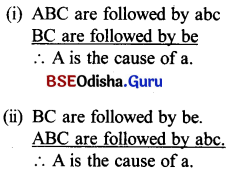
![]()
![]()
![]()
![]()
![]()
![]()
![]()
![]()
![]()
![]()
![]()
![]()



